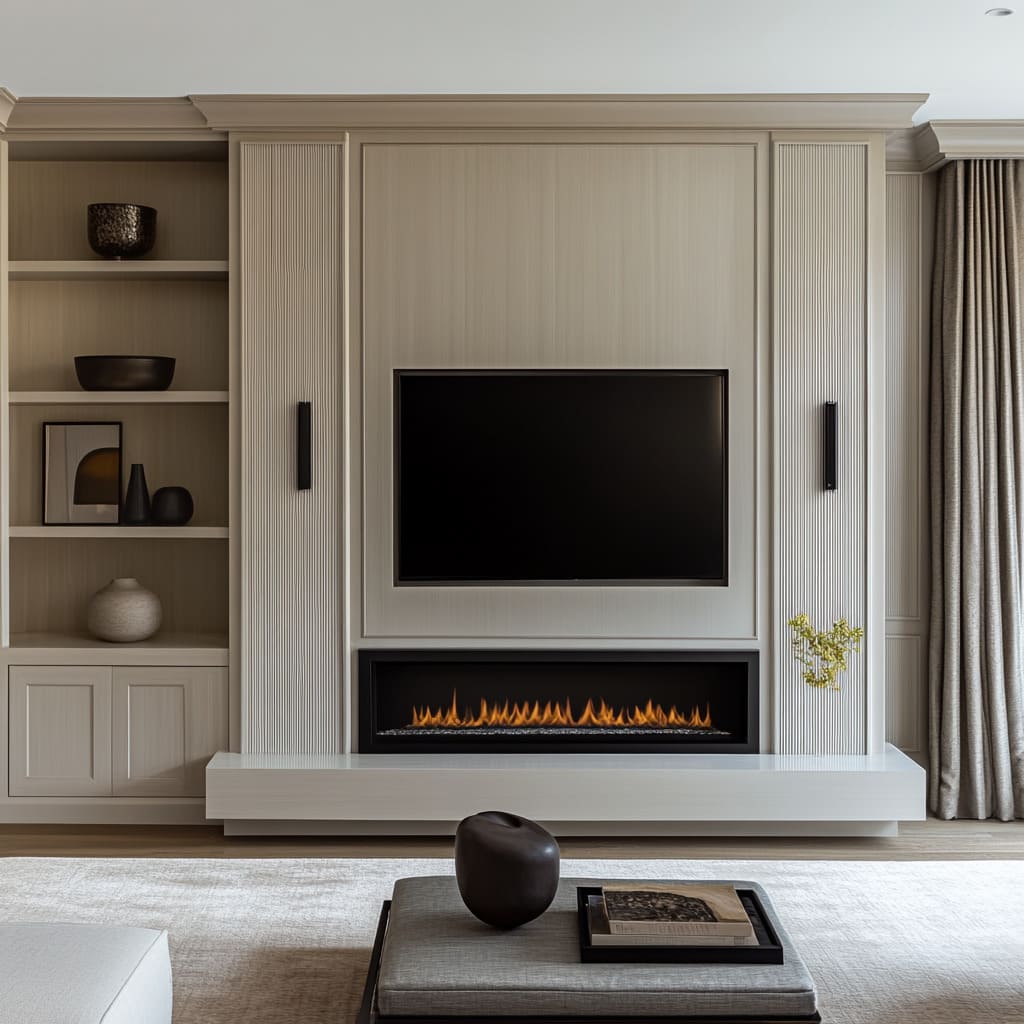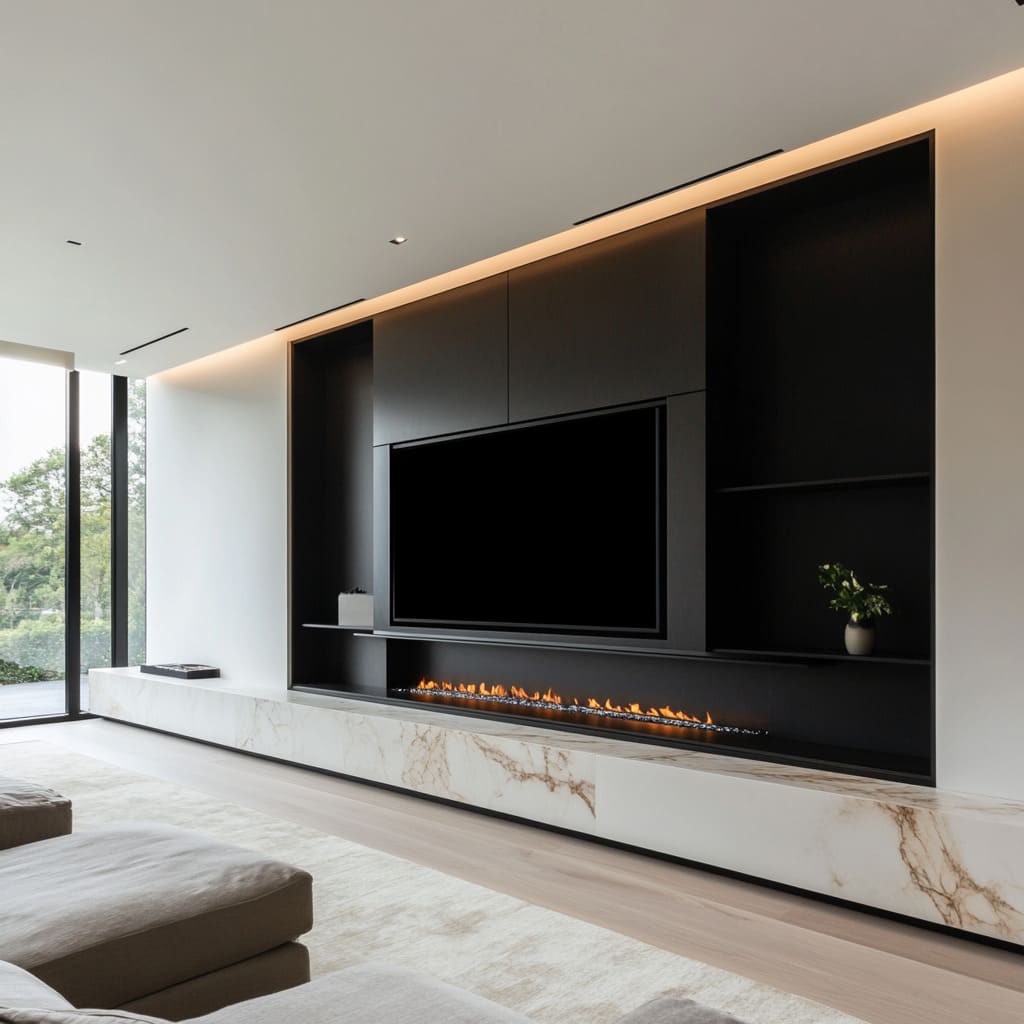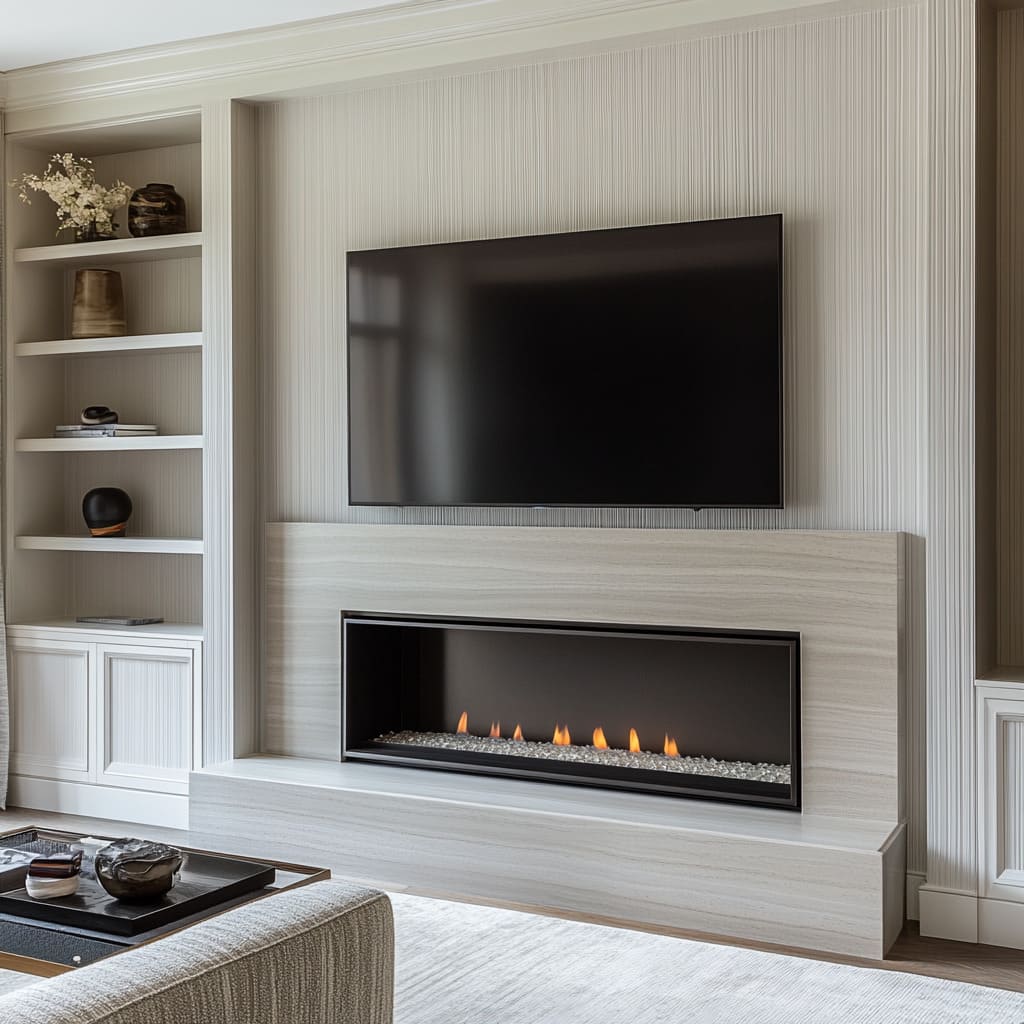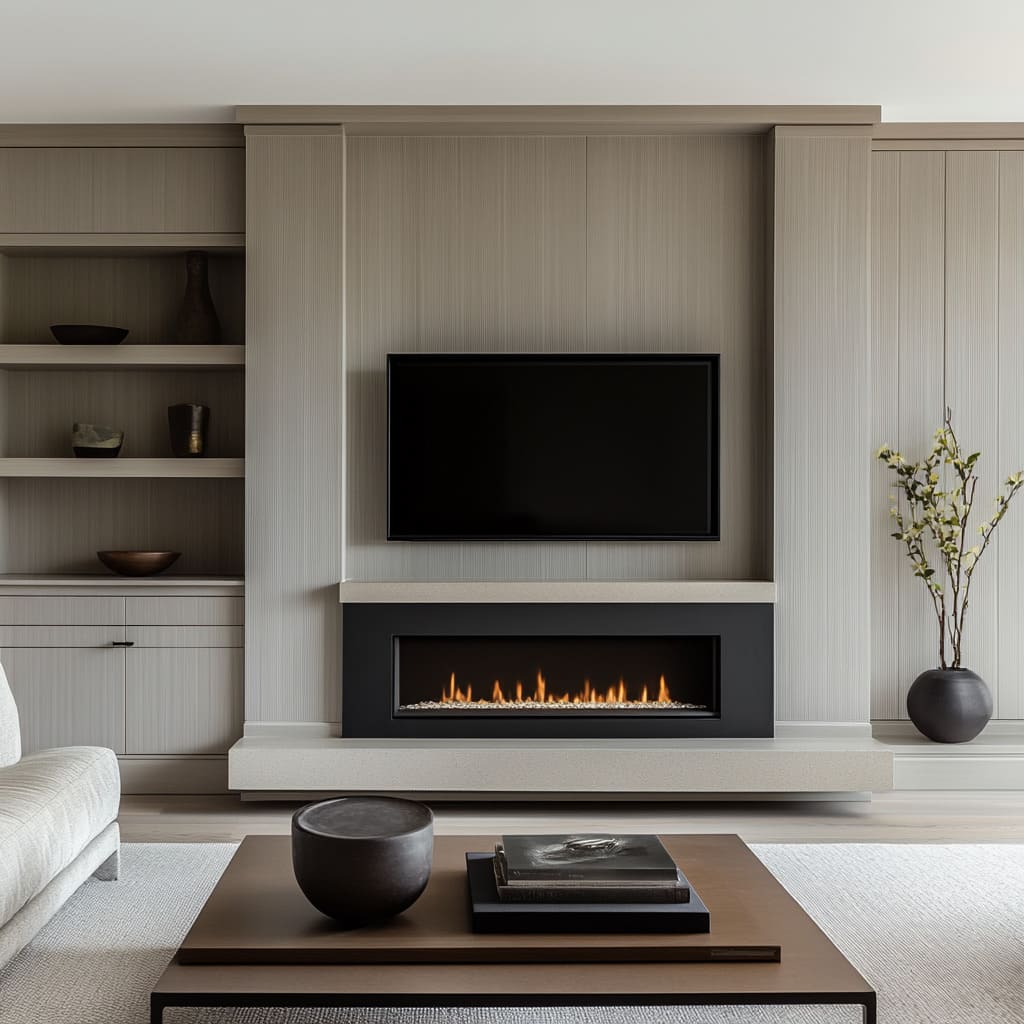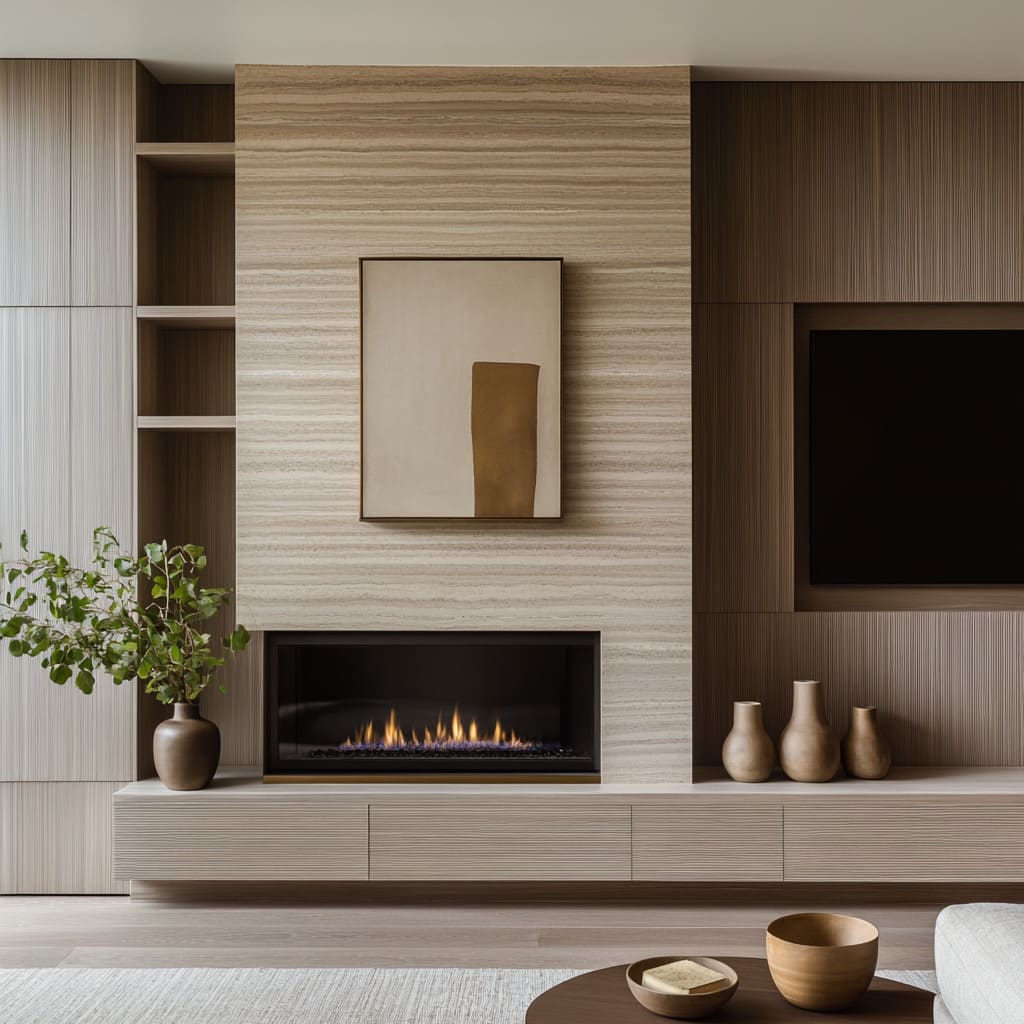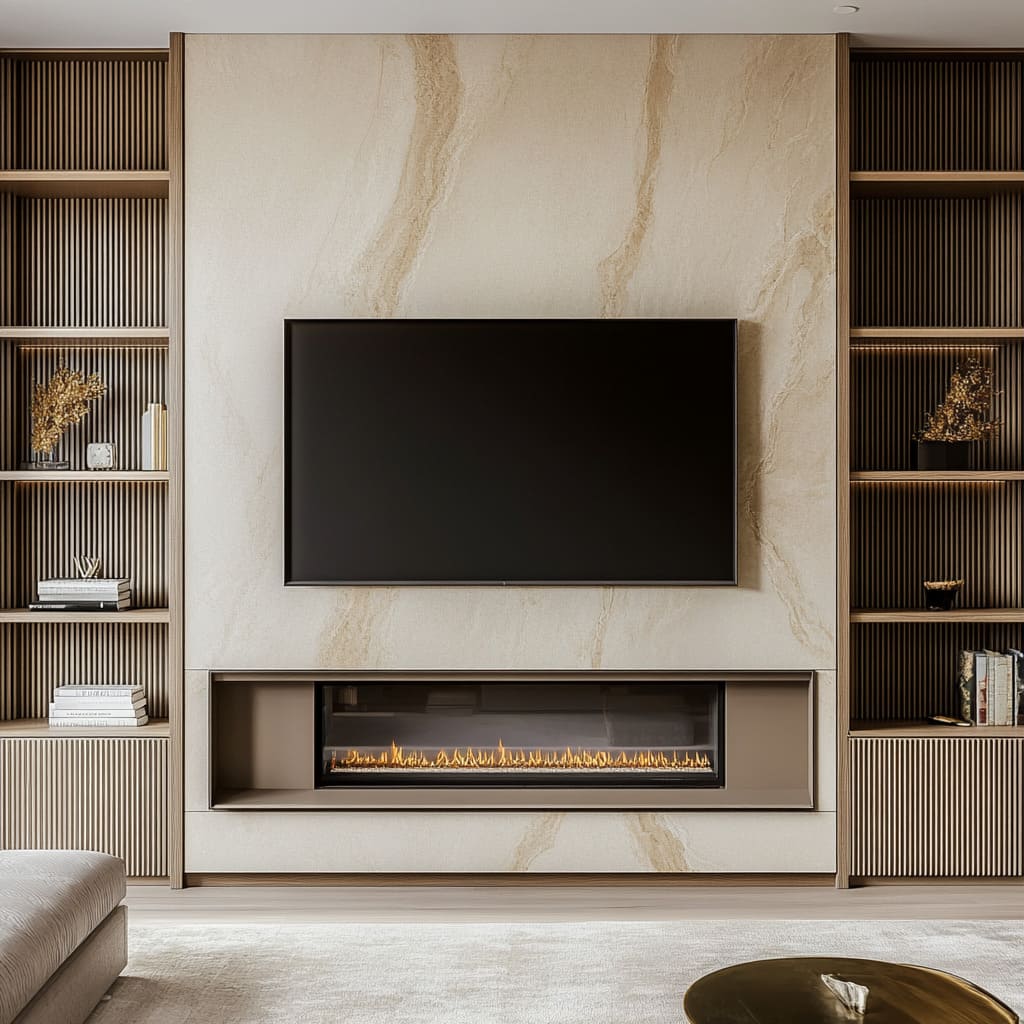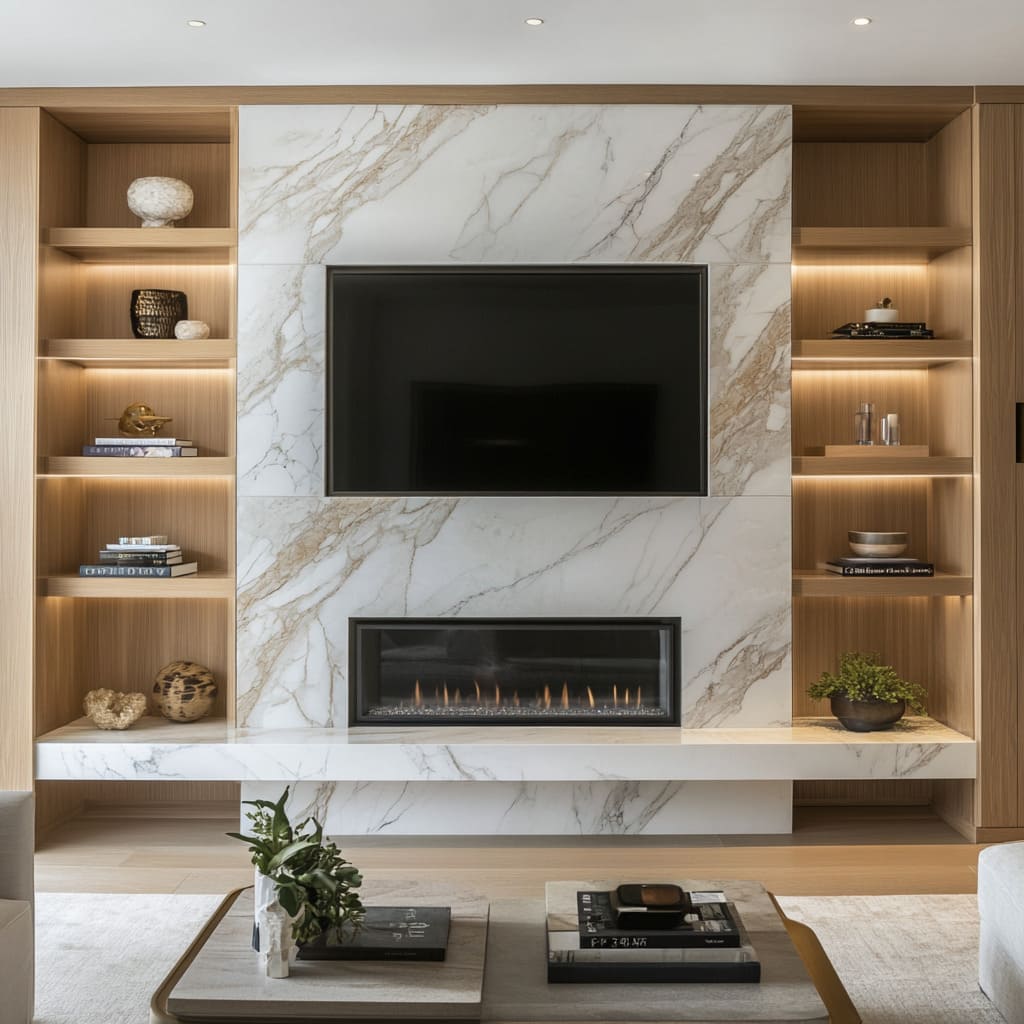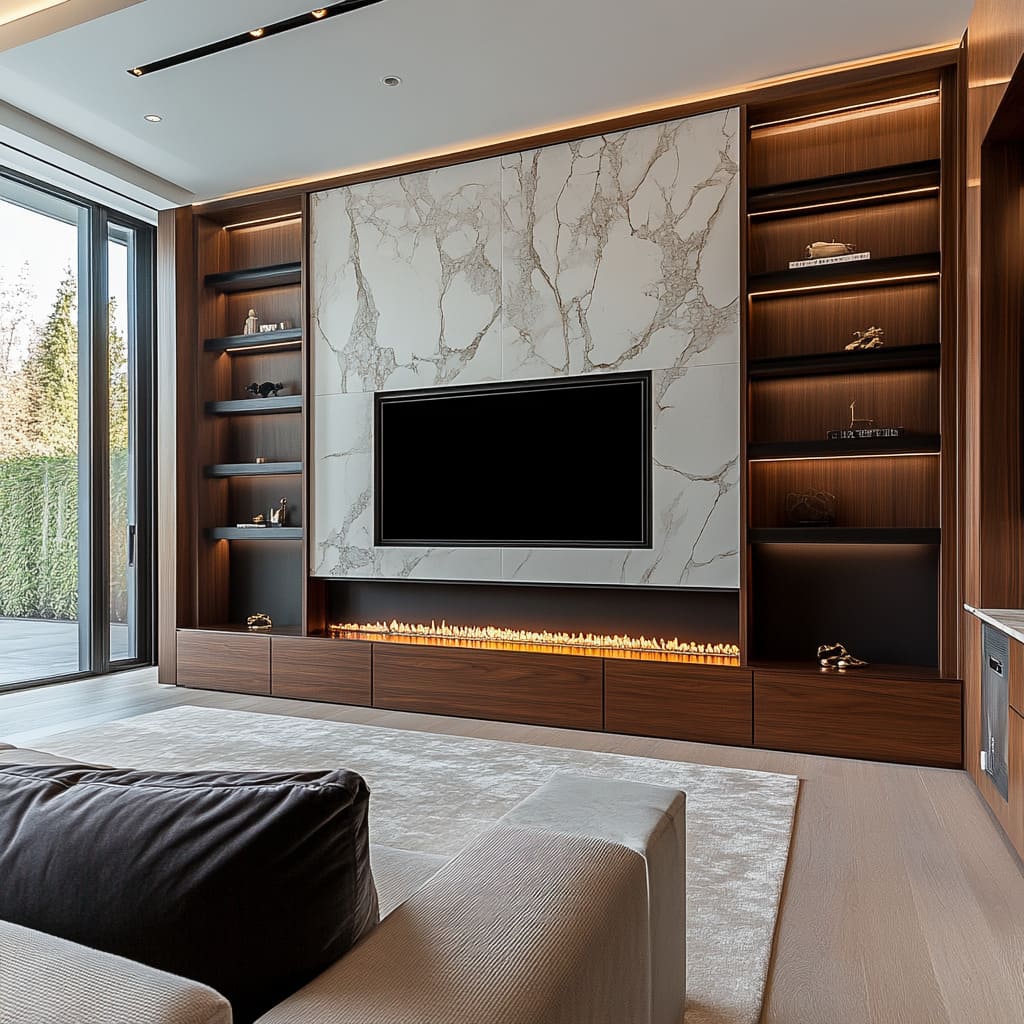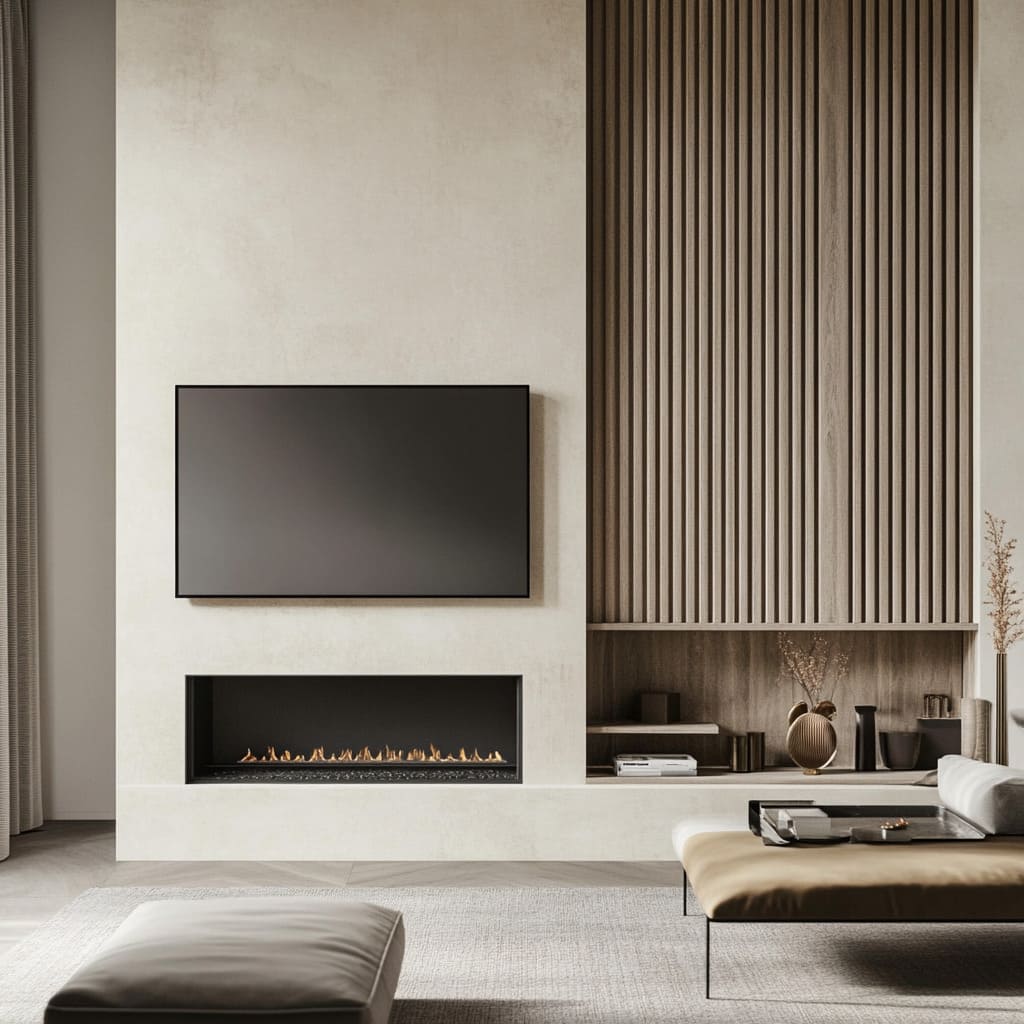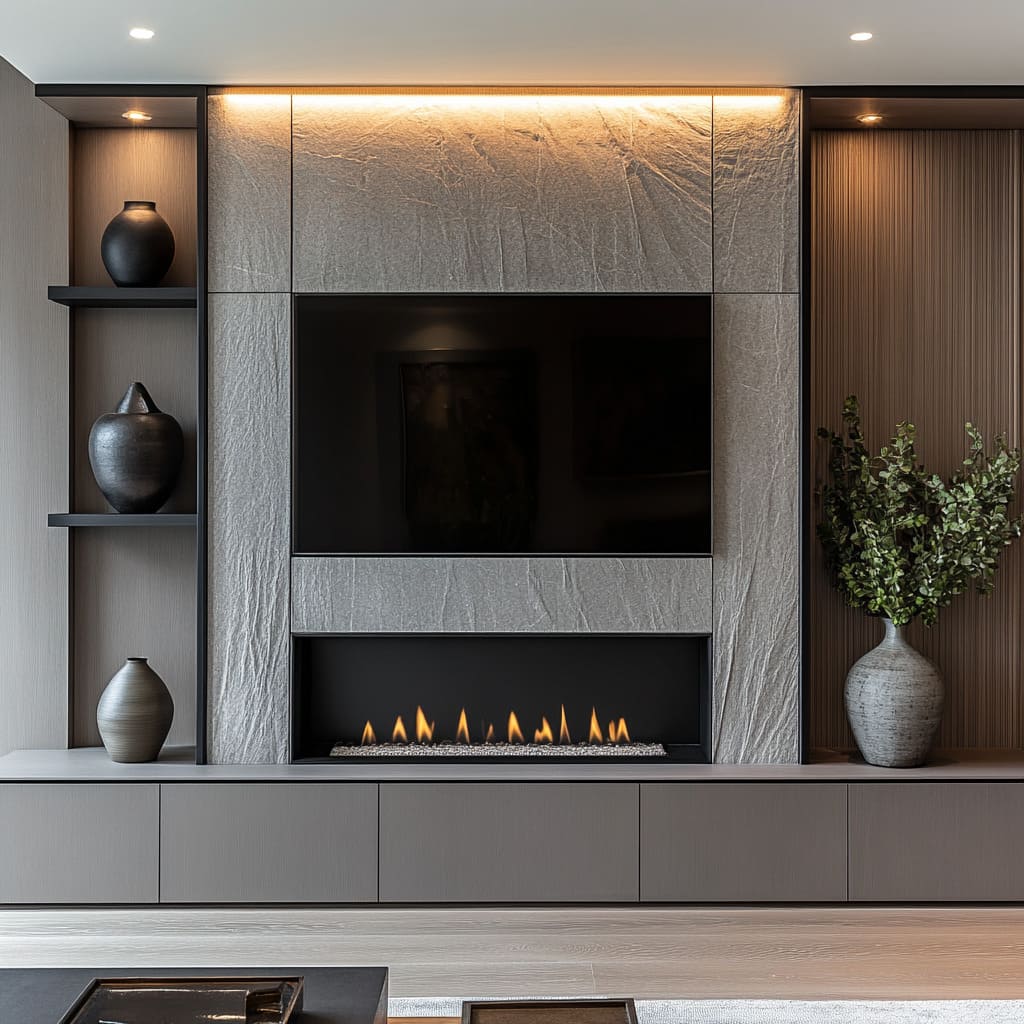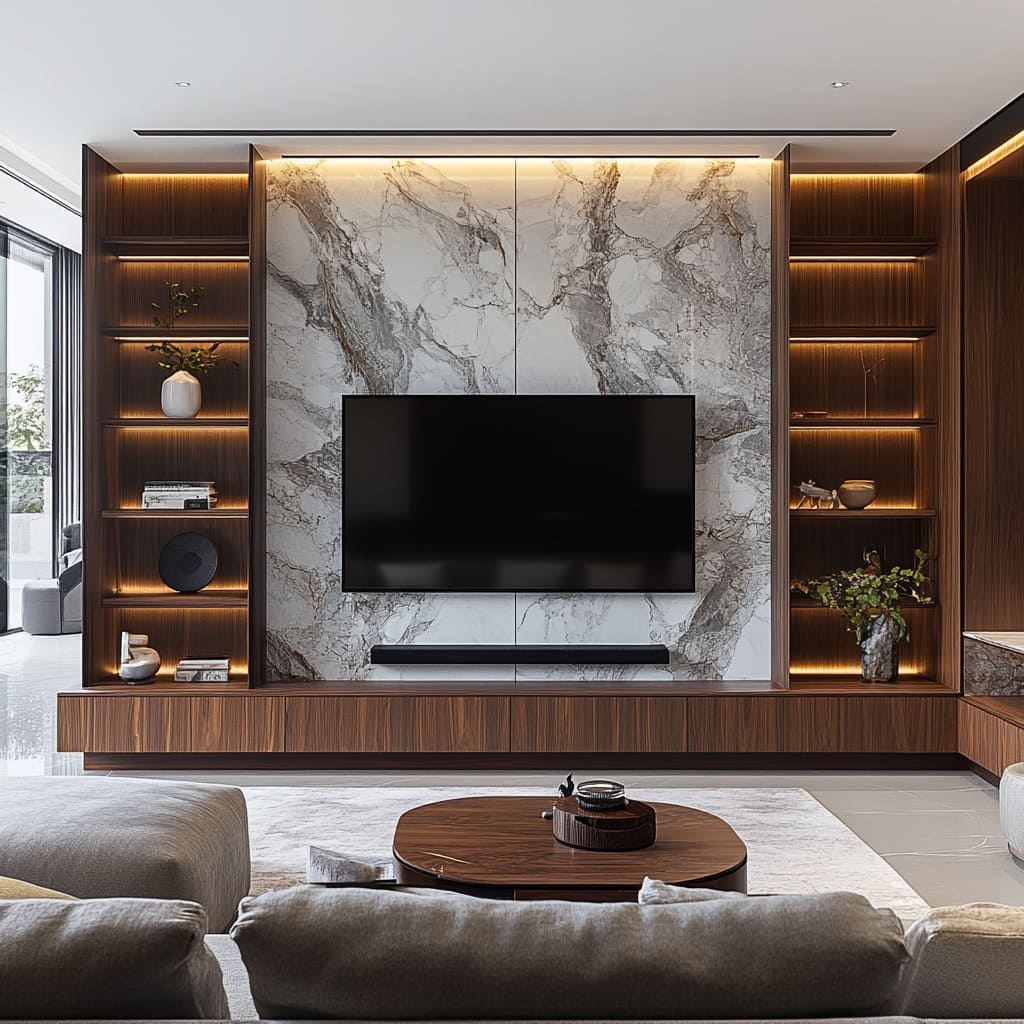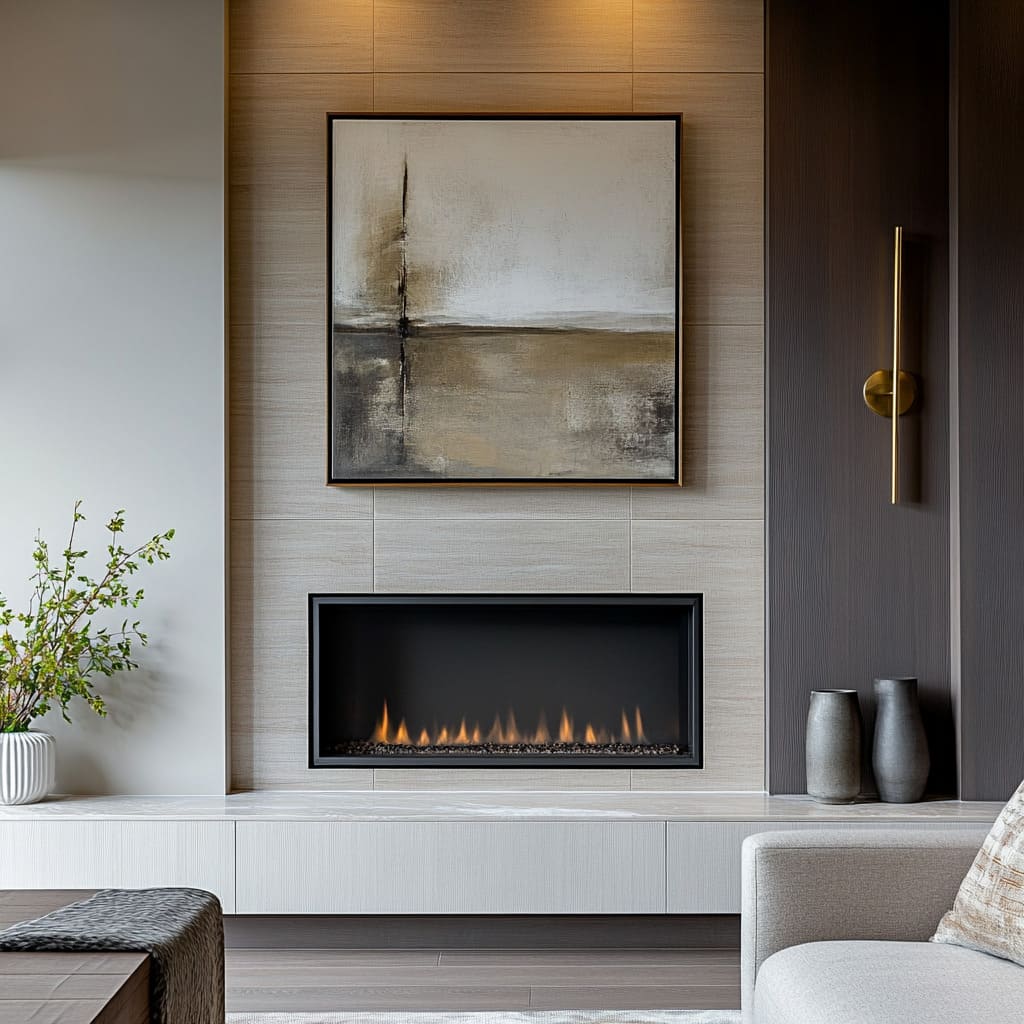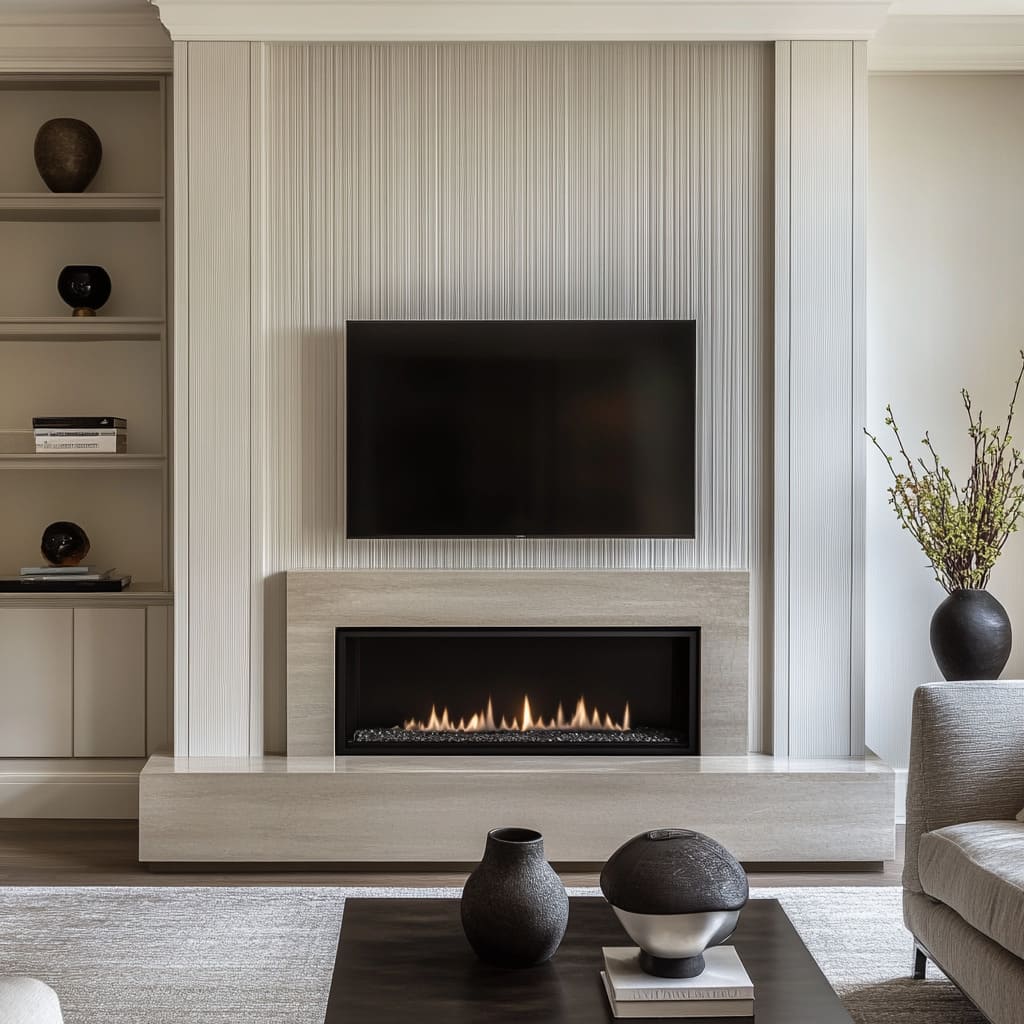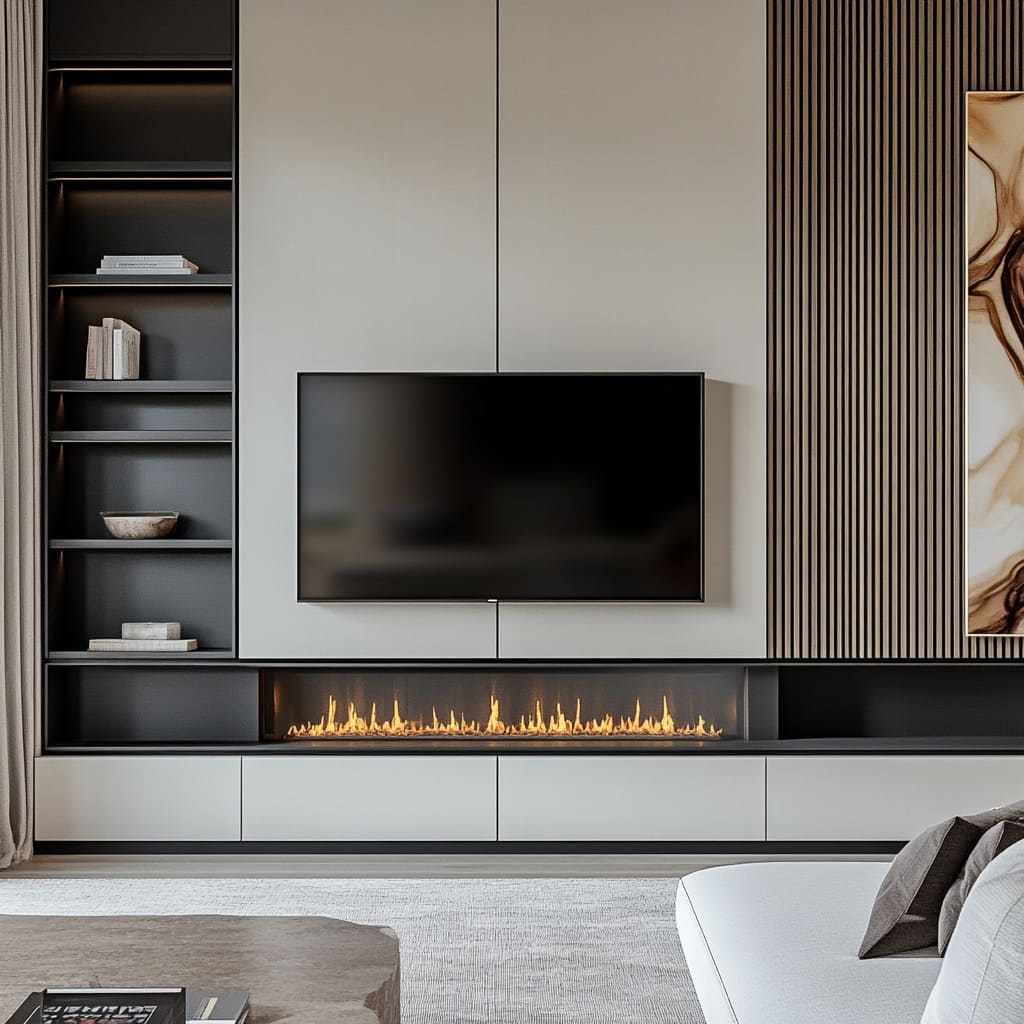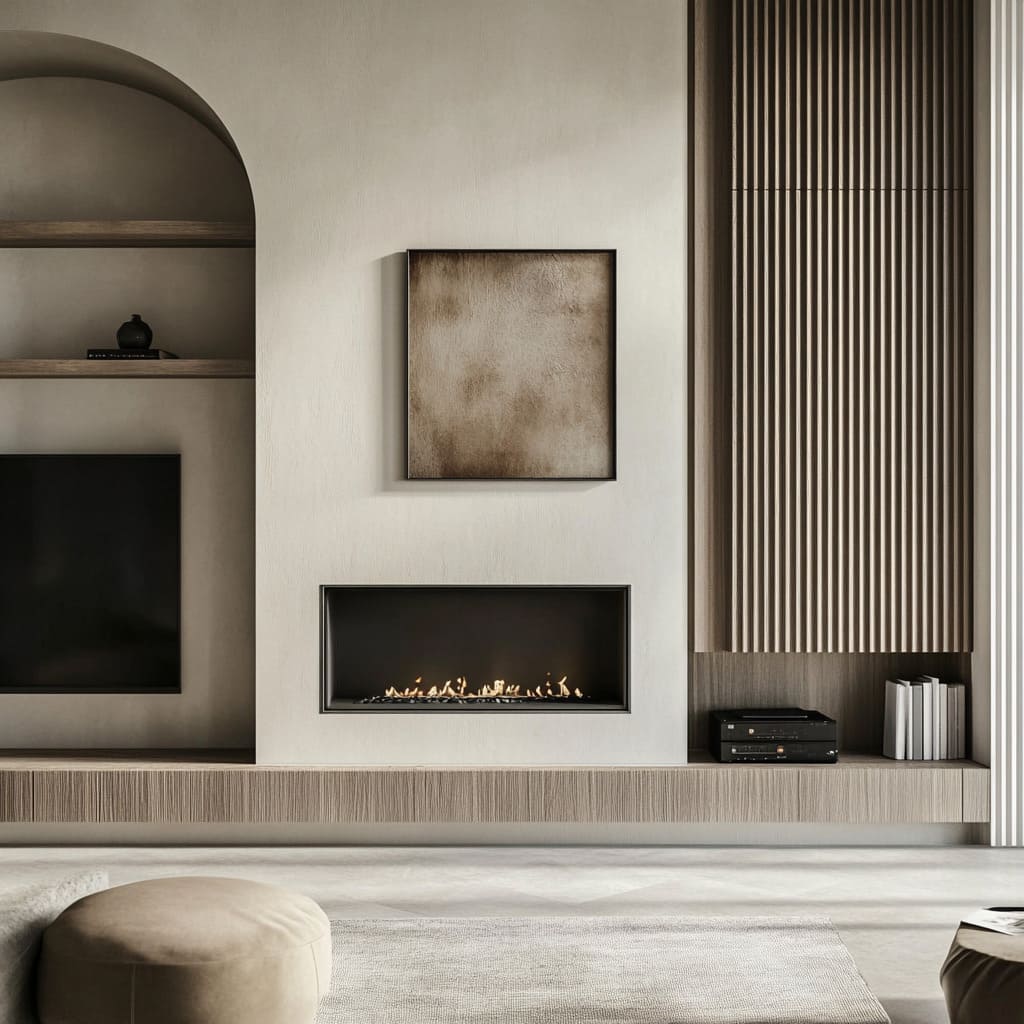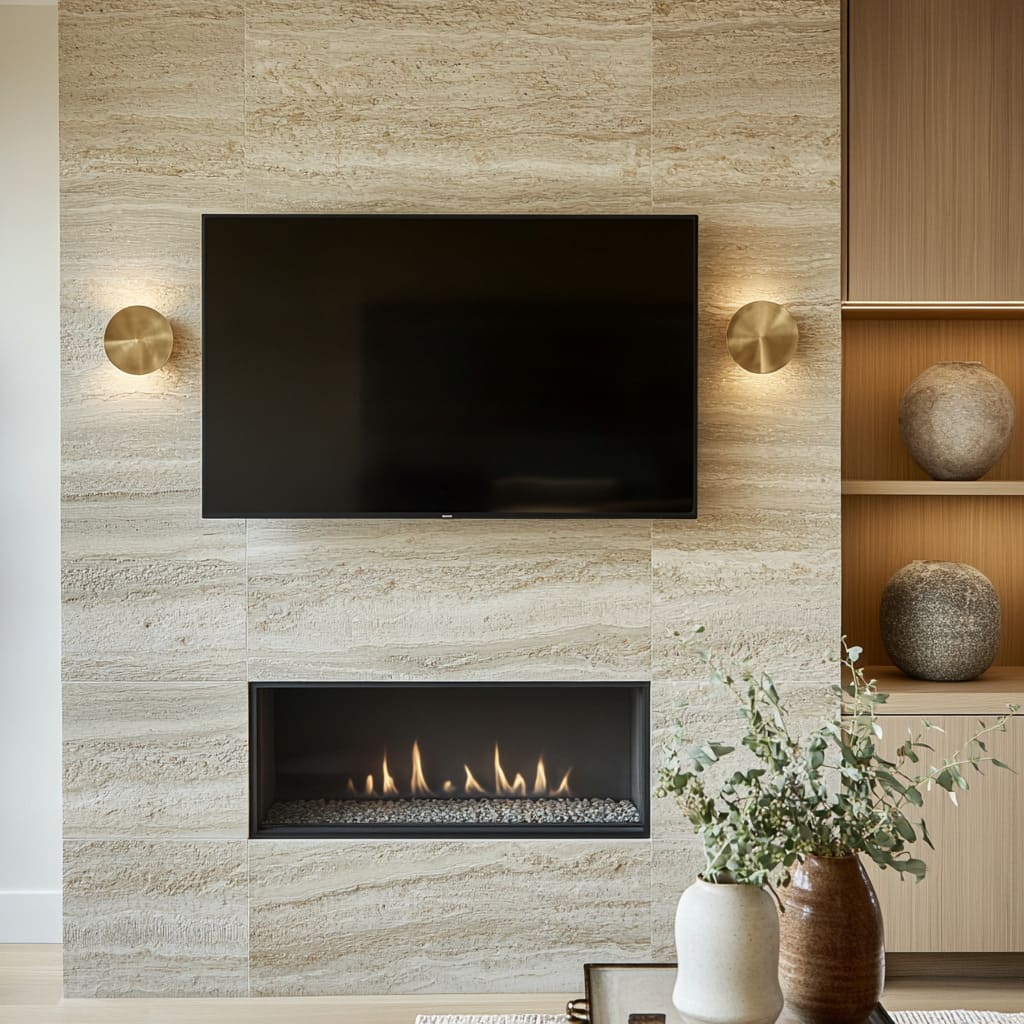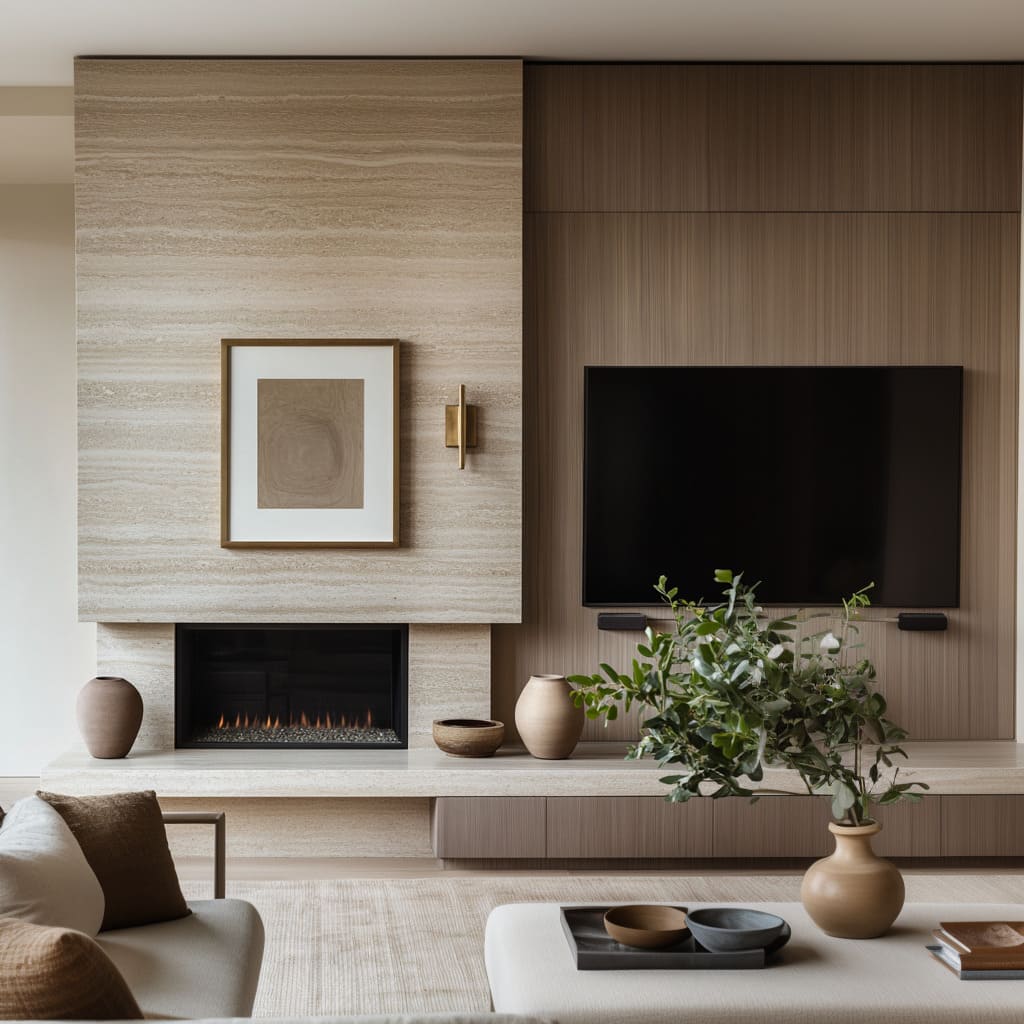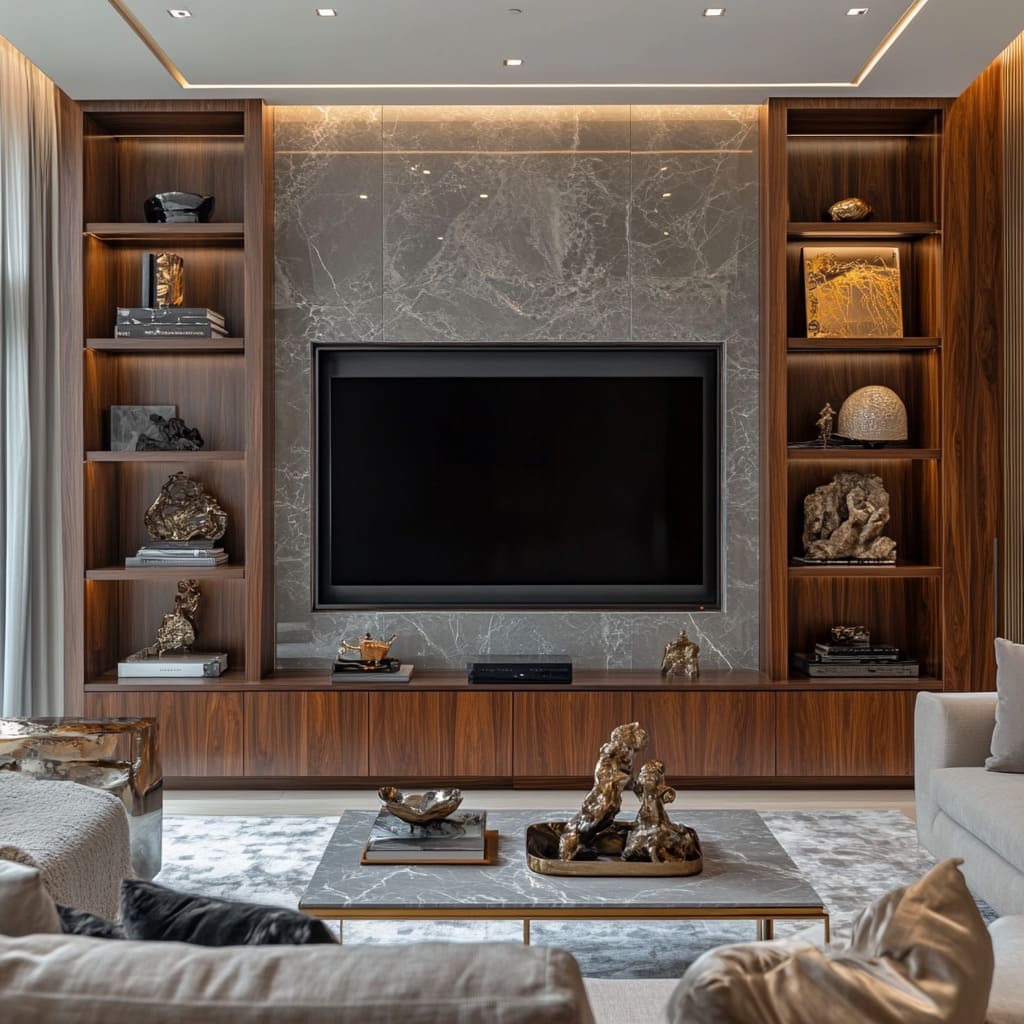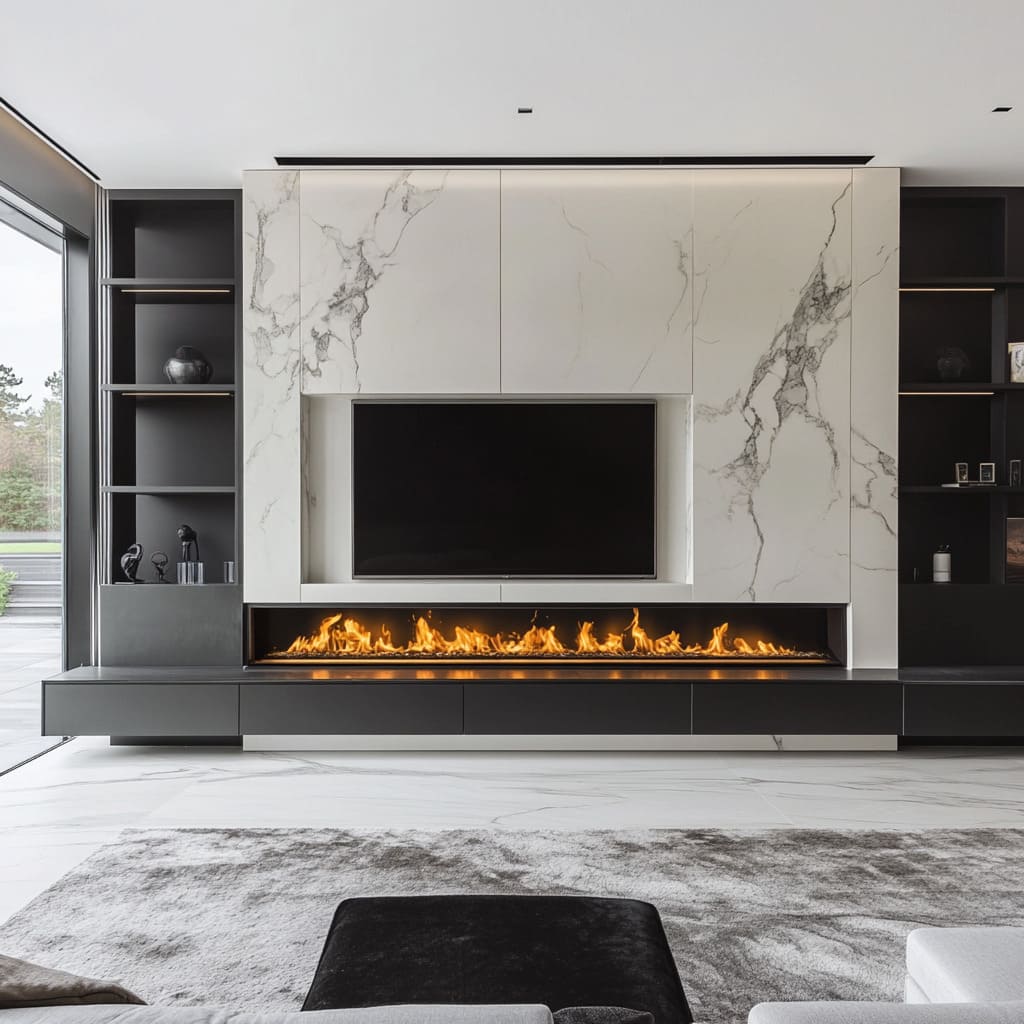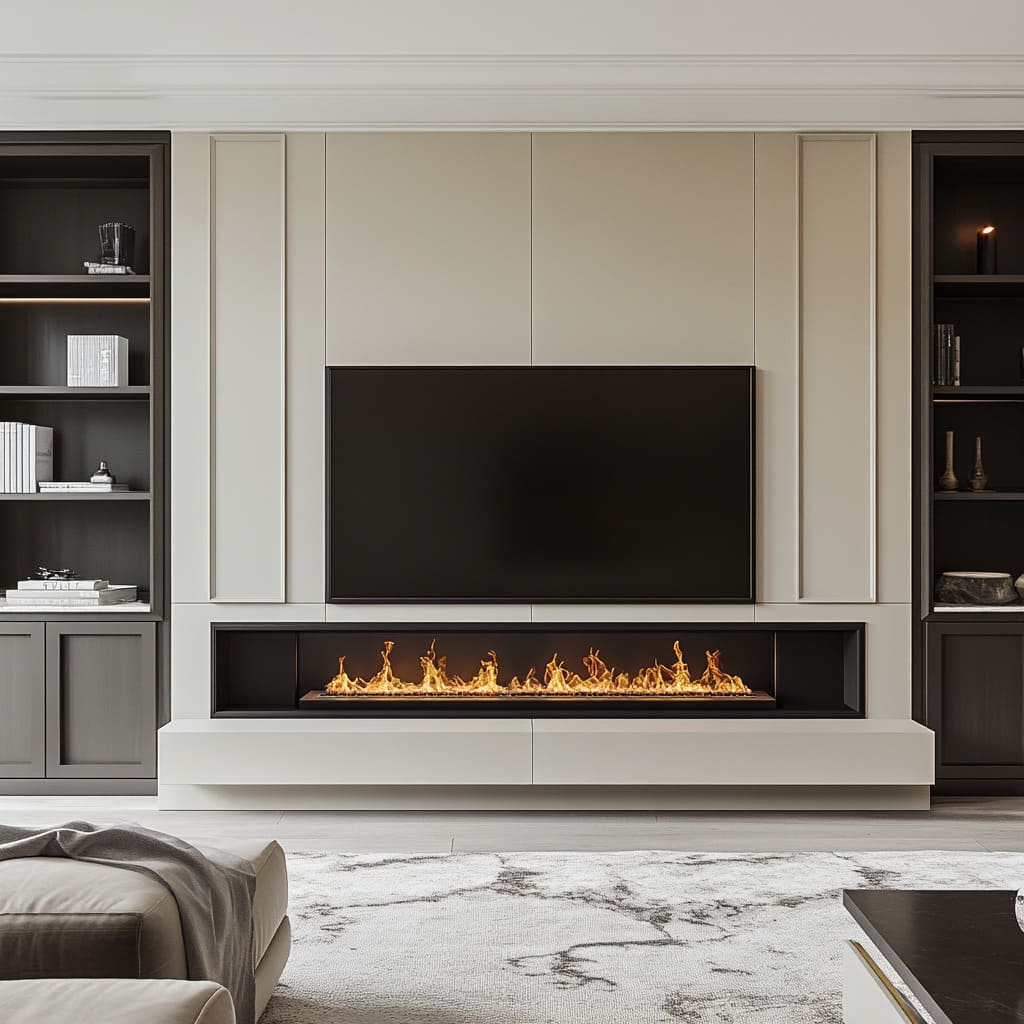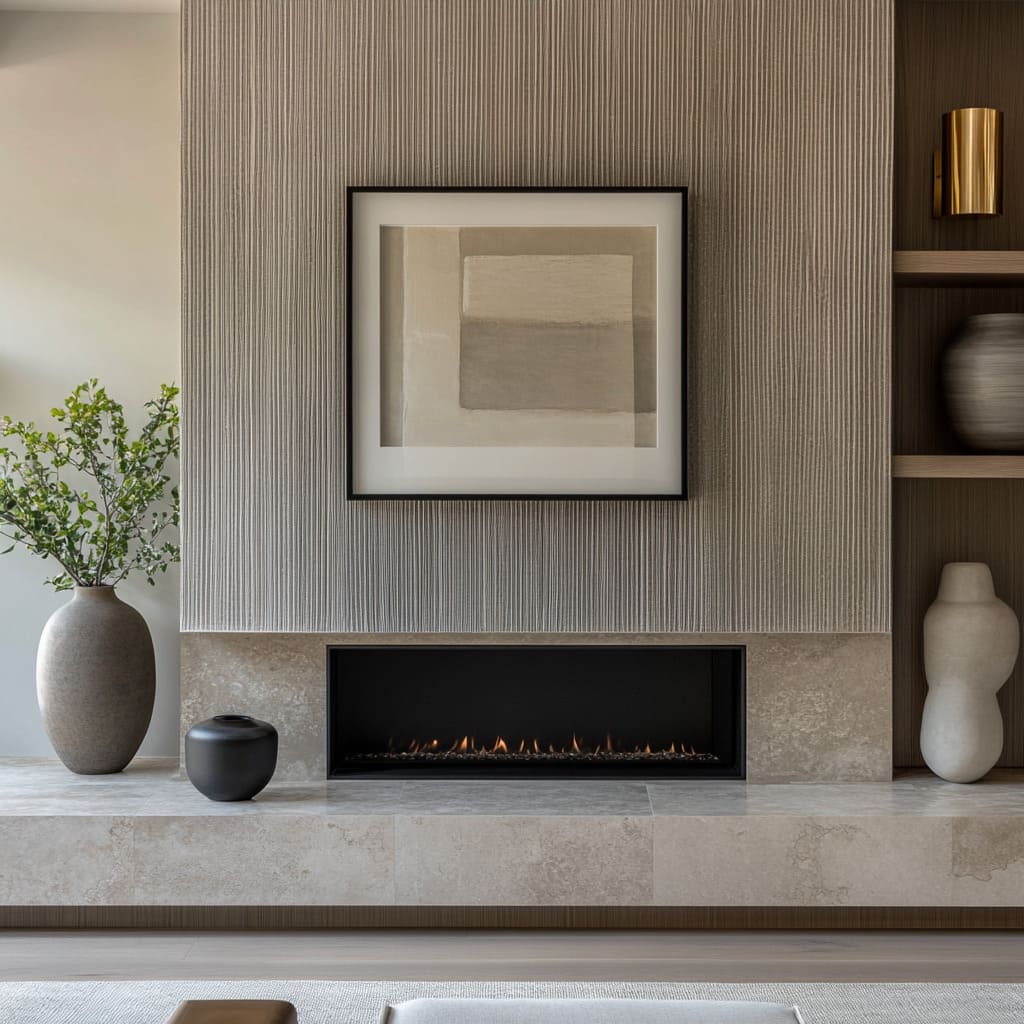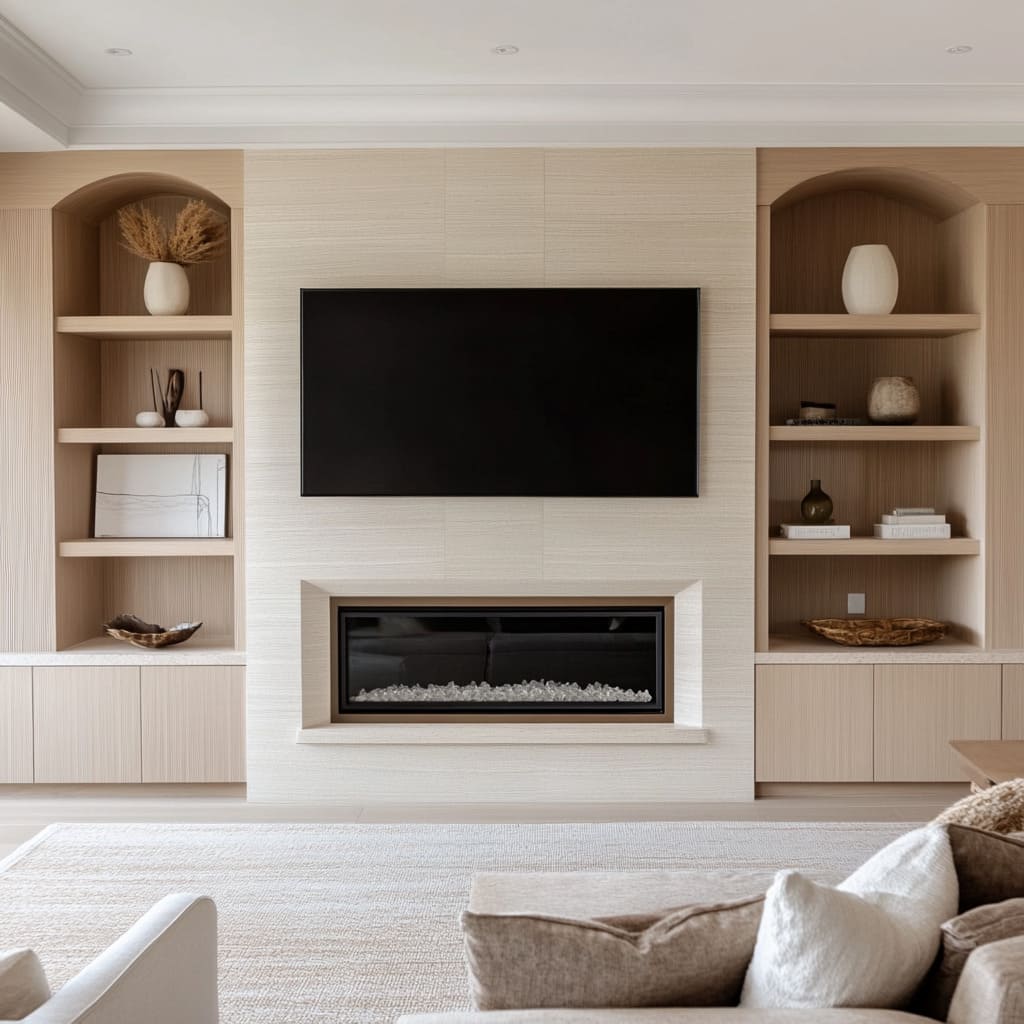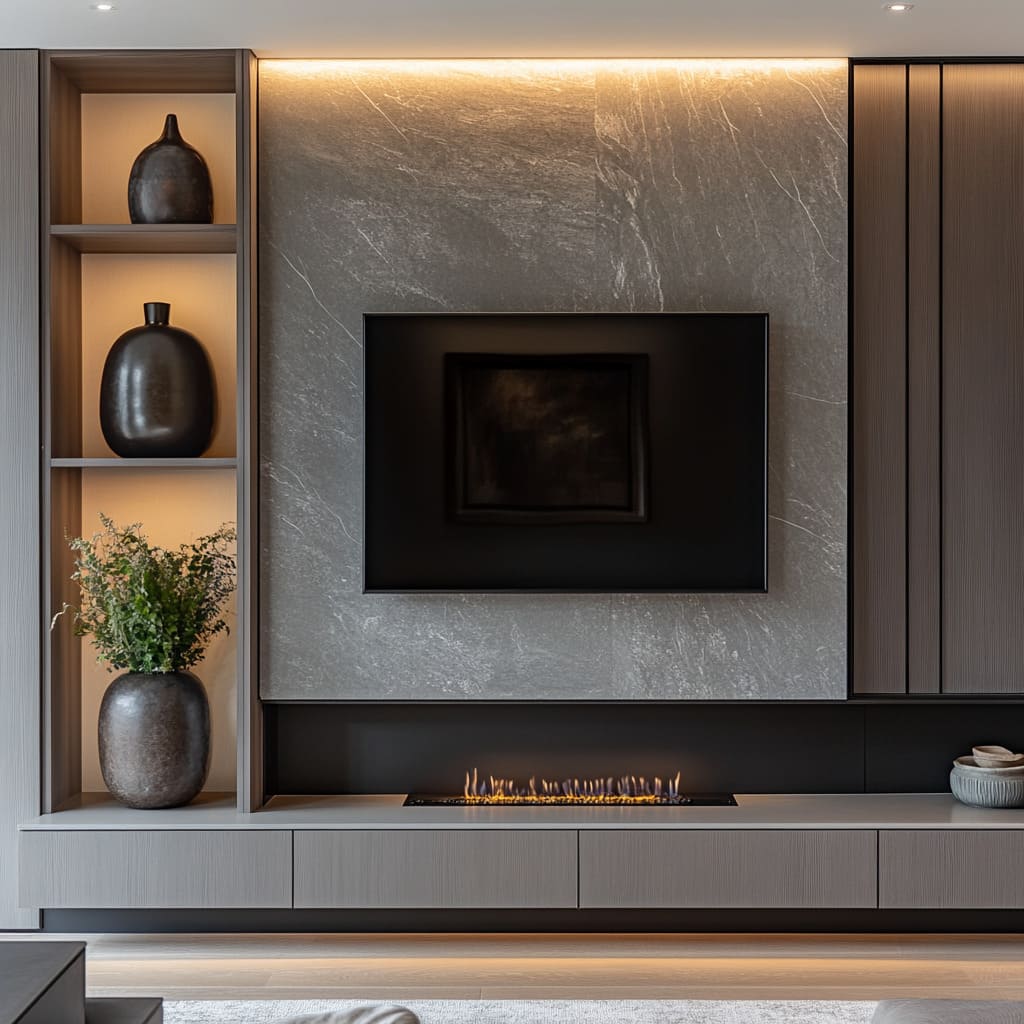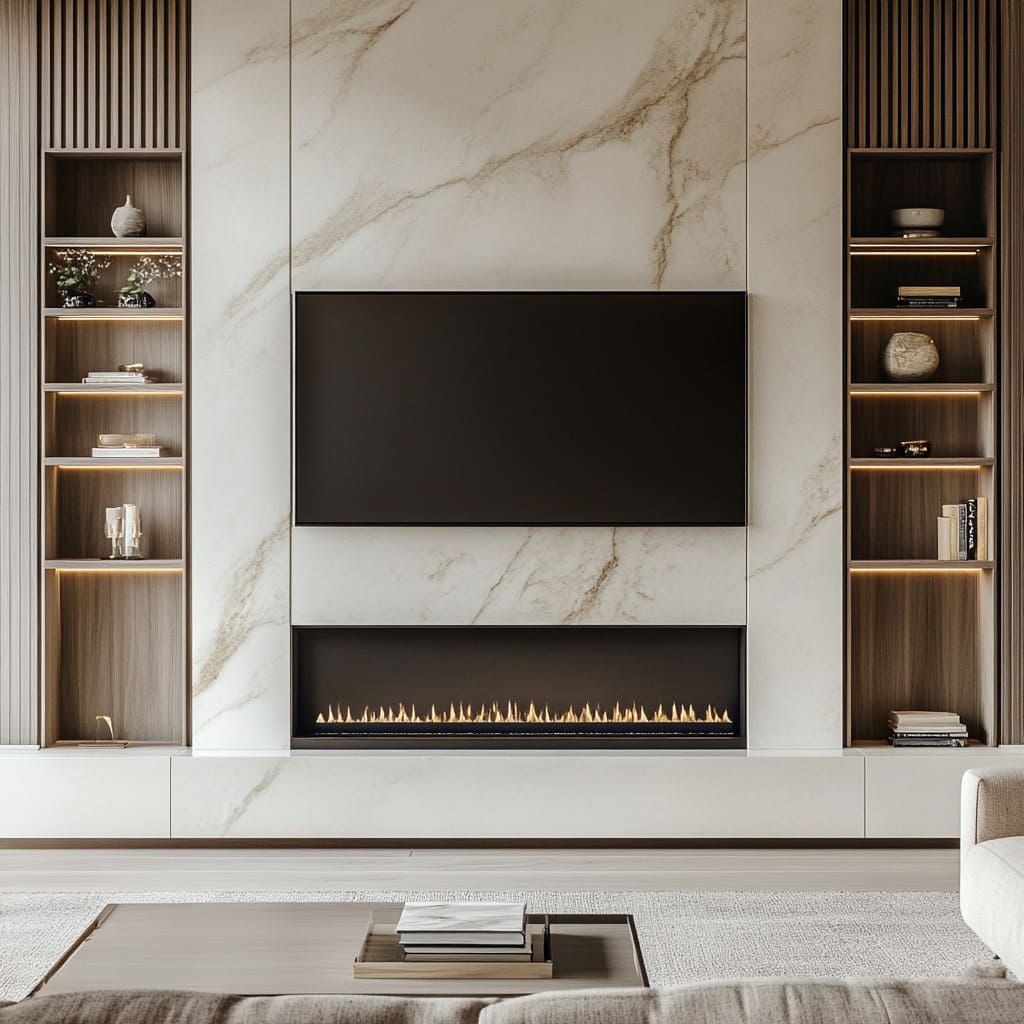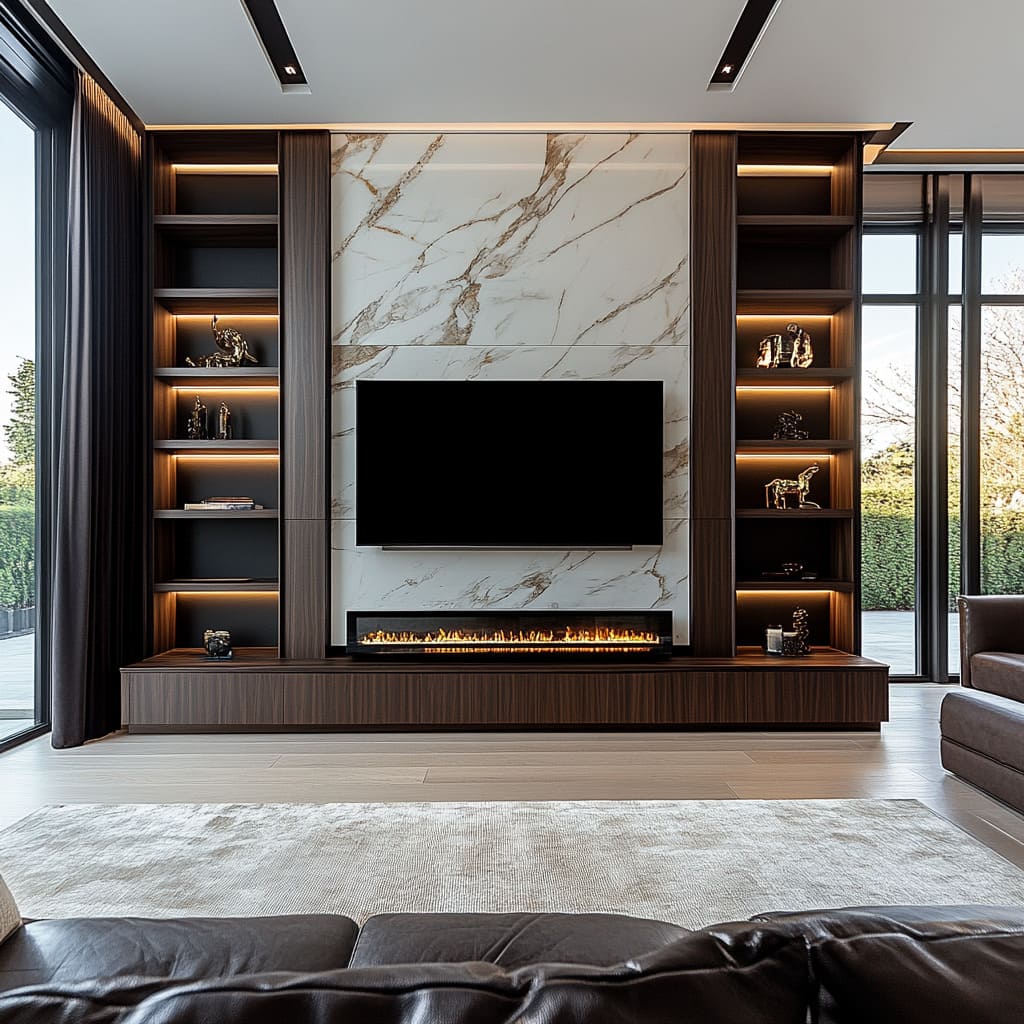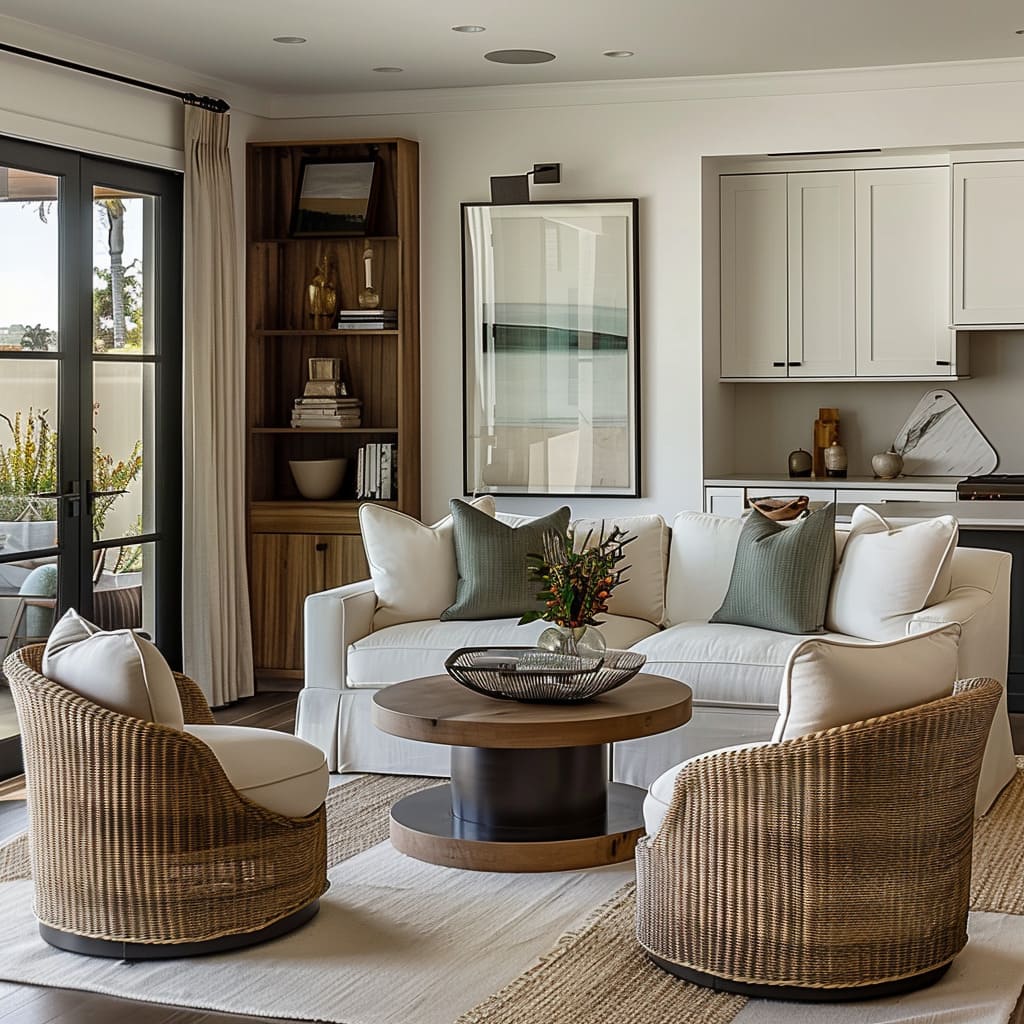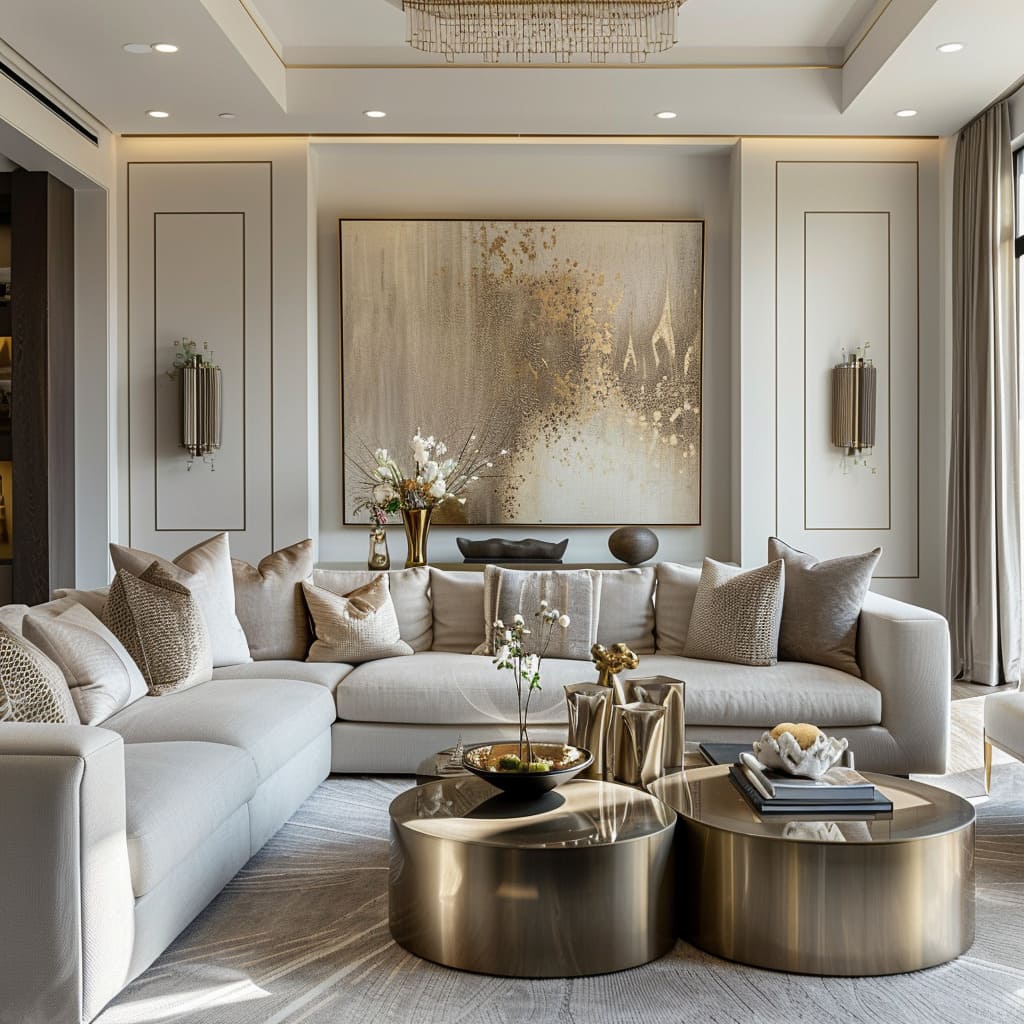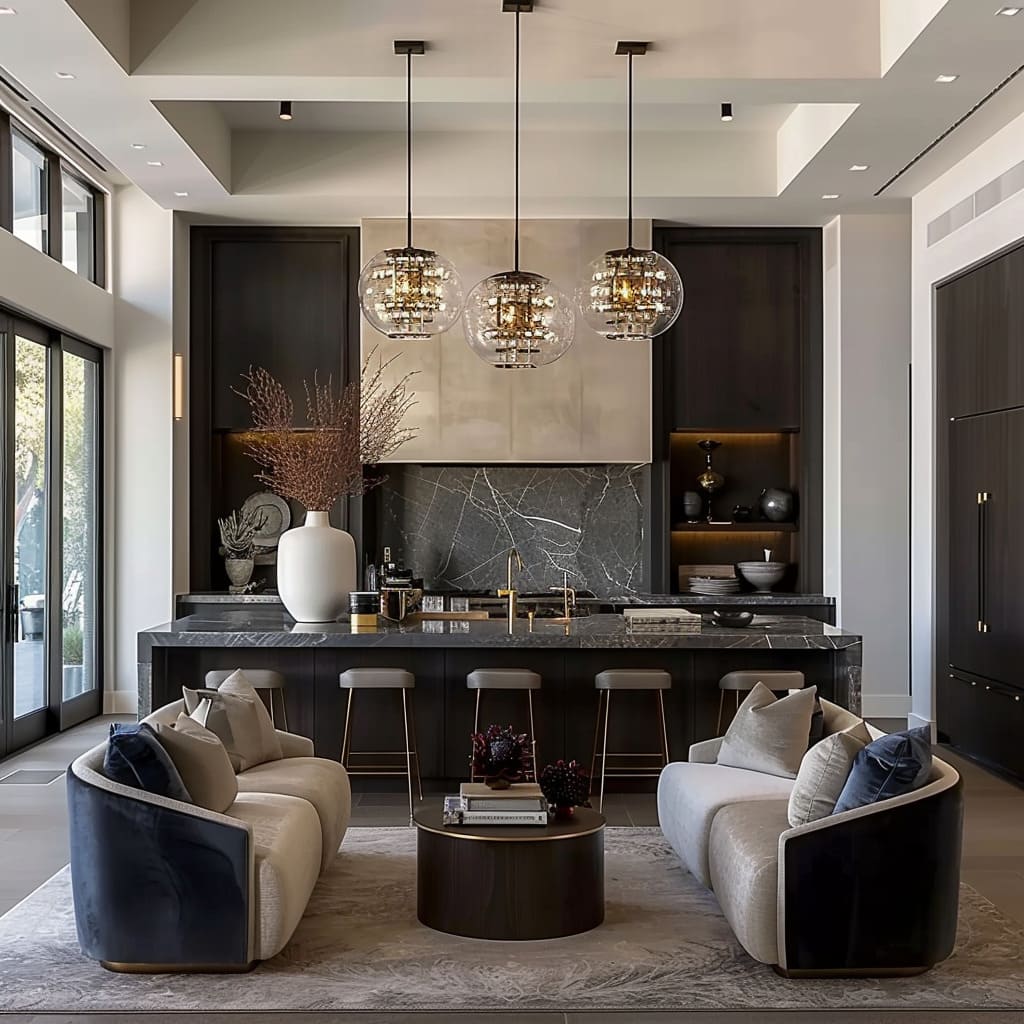Over the years, the living room has evolved from a simple gathering space into a central hub of modern homes. It’s where families come together, where guests are entertained, and where daily life unfolds.
As such, the design of this space has become increasingly important, with homeowners seeking to combine function with a sense of luxury. One of the most prominent features in today’s living rooms is the TV unit wall—a design element that has gone beyond merely housing a television. These walls have transformed into the focal point of the room, showcasing a blend of high-end materials, smart technology, and sophisticated style.
In this article, we will explore the latest trends in TV unit wall designs that are redefining living spaces in American homes
The Evolution of TV Unit Wall Designs in American Homes
Living rooms in American homes have undergone a significant transformation over the decades. Once a space dominated by bulky entertainment centers and oversized furniture, the modern living room now favors clean lines, open spaces, and a blend of form and function.
The TV unit wall is a perfect example of this evolution. It has transitioned from a simple necessity—merely a spot to hang the television—into a statement piece that reflects the homeowner’s style and taste. This shift has been driven by a growing appreciation for design that enhances the overall aesthetic of the home while also serving practical purposes.
As technology continues to advance, so too does the integration of media into our living spaces, leading to TV unit walls that are not only functional but also a central design feature in contemporary American homes.
Material Mastery: The Role of Marble, Wood, and Metal
Marble’s Luxurious Appeal:
One of the most striking materials being used in TV unit wall designs today is marble. Its natural beauty, with unique veining and patterns, brings a sense of grandeur to any space.
Marble is no longer confined to countertops or floors; it has found its place on the walls, particularly behind televisions. The choice of marble, whether it’s a clean white slab with subtle veins or a darker variety with bold, dramatic patterns, can drastically influence the room’s ambiance. The polished surface of marble reflects light in a way that adds depth to the room, making the space feel larger and more open.
The use of bookmatched marble, where the slabs are mirrored to create a symmetrical pattern, further enhances the visual impact, turning the TV wall into a piece of art. This material choice is particularly popular in homes that aim to combine modern design with a touch of timeless elegance
The Warmth of Wood:
While marble offers a cool, polished look, wood brings warmth and texture, creating a balanced contrast. Wood has always been a favorite in interior design for its versatility and natural appeal. In TV unit wall designs, wood is often used in the form of vertical slat paneling or cabinetry, adding an organic element that softens the hard lines of modern technology.
The trend of using grey-toned wood or darker varieties provides a contemporary twist on this classic material, complementing the sleek surfaces of marble and metal. Wood’s ability to add coziness without sacrificing style makes it an ideal choice for living rooms that need to feel both luxurious and inviting. In many designs, wood cabinetry also offers practical storage solutions, keeping the area tidy and uncluttered while enhancing the room’s overall aesthetic
Subtle Metal Accents:
Metal accents are the finishing touches that can elevate a TV unit wall from simple to sophisticated. Bronzed mirrors, black metal frames, and sleek soundbars are just a few examples of how metal can be used to enhance the design. These elements add a modern, industrial edge, contrasting with the natural materials used elsewhere in the design.
The use of metal is about more than just aesthetics; it’s also about durability and functionality. For instance, a black metal frame around a fireplace or television not only draws the eye but also provides a durable edge that protects these elements from wear and tear.
The integration of metal with other materials creates a balanced design that is both visually appealing and built to last.
How does the integration of a linear gas fireplace beneath a television, particularly when framed by materials like marble and black metal, alter the overall balance between warmth and modernity in a living room design?
The integration of a linear gas fireplace beneath a television, framed by materials like marble and black metal, significantly alters the balance between warmth and modernity in a living room design by creating a striking juxtaposition of elements The fireplace introduces a dynamic, living element with its flickering flames, which inherently adds a sense of warmth and comfort to the space This warmth is both literal and visual, as the flames create a cozy atmosphere that softens the otherwise sleek and modern lines of the TV and its surrounding frame. When the fireplace is surrounded by polished marble, particularly with dramatic veining, it elevates the room’s sophistication and gives the space a sense of luxury The reflective quality of the marble enhances the light and movement from the flames, further adding to the room’s inviting ambiance On the other hand, the use of black metal as a framing element introduces an industrial edge, reinforcing the modern aspect of the design The metal’s clean, sharp lines contrast with the organic patterns in the marble and the fluid motion of the flames, striking a balance that blends the warmth of traditional design with the sleekness of contemporary style This combination results in a space that feels both grounded and luxurious, where the modernity of the metal and television is tempered by the natural beauty and warmth of the fireplace and marble It creates a living room that is visually compelling, comfortable, and sophisticated, making it an ideal setting for both relaxation and socializing.
In what ways does the use of bookmatched marble, with its symmetrical veining, influence the perception of space and harmony within a living room that incorporates darker wood tones and vertical slat paneling?
The use of bookmatched marble, with its symmetrical veining, profoundly influences the perception of space and harmony within a living room that incorporates darker wood tones and vertical slat paneling Bookmatched marble creates a mirrored effect where the natural veining forms a continuous, flowing pattern, introducing a strong sense of symmetry and order to the space This symmetry is visually calming, guiding the eye across the surface and enhancing the feeling of balance within the room. When paired with darker wood tones, the marble’s lighter, reflective surface helps to counterbalance the room’s overall warmth The contrast between the cool marble and the rich wood tones creates a dynamic interplay, making the space feel more expansive and open The light marble serves to lift and brighten the darker elements, ensuring that the room doesn’t feel too heavy or enclosed Vertical slat paneling adds another layer of texture and rhythm to the space The vertical lines draw the eye upward, emphasizing the height of the room and complementing the horizontal flow of the marble veining Together, these elements work to create a harmonious environment where the marble’s natural patterns provide a soothing backdrop that balances the more structured, linear elements of the wood and paneling The result is a living room that feels both spacious and cohesive, with each material contributing to an overall sense of elegance and tranquility.
How do subtle lighting elements, such as LED strips or recessed lighting within wood cabinetry, enhance or transform the interplay between metal accents and natural materials like marble and wood in a sophisticated living room setting?
Subtle lighting elements, such as LED strips or recessed lighting within wood cabinetry, play a crucial role in enhancing and transforming the interplay between metal accents and natural materials like marble and wood in a sophisticated living room setting These lighting elements are strategically placed to highlight the textures and finishes of the materials, creating a layered effect that adds depth and dimension to the space
LED strips, when placed along the edges of marble surfaces or within the joints of metal frames, can accentuate the veining in the marble and the sleek lines of the metal, making these materials stand out more vividly The gentle glow from the LED strips brings out the richness of the marble’s patterns and the subtle reflections of the metal, creating a visual contrast that is both striking and elegant
Recessed lighting within wood cabinetry serves a dual purpose: it illuminates the objects displayed on the shelves and enhances the natural grain and warmth of the wood This type of lighting casts a soft, ambient glow that interacts with the reflective qualities of metal and marble, creating a harmonious balance between the cool, polished surfaces and the warm, textured wood The result is a living room that feels both cozy and refined, with each material complementing the others in a carefully orchestrated interplay of light and shadow Overall, the use of subtle lighting elevates the entire design, transforming the room into a space where the beauty of each material is fully appreciated, and the overall ambiance is one of understated luxury and comfort.
Lighting: The Unsung Hero of TV Wall Design
Ambient Lighting for Atmosphere:
Lighting plays a crucial role in any interior design, but when it comes to TV unit walls, it’s especially important. Ambient lighting, in particular, is key to creating a mood that enhances the visual appeal of the space. LED strips, recessed lighting, and backlighting are commonly used to highlight the textures and materials of the TV wall.
For example, LED strips placed behind a marble panel can accentuate the stone’s natural veining, casting soft shadows that add depth and interest to the wall. Recessed lighting in the shelving units not only illuminates the objects on display but also creates a warm, inviting glow that makes the entire room feel more welcoming.
The careful placement of lighting ensures that the focus is on the design, highlighting the elements that make the space unique.
Task Lighting for Functionality:
While ambient lighting sets the mood, task lighting serves a more practical purpose. It’s used to illuminate specific areas, such as media storage or decor displays, ensuring that these spaces are both functional and easy to use. In TV unit wall designs, task lighting is often integrated into the shelving, providing targeted light that enhances the visibility of books, art pieces, or other decorative objects.
This type of lighting is subtle, often hidden within the structure of the shelves, but its impact is significant. It helps to draw attention to the details of the design without overwhelming the space with unnecessary brightness. By combining task and ambient lighting, designers can create a layered lighting scheme that enhances both the form and function of the TV unit wall
How does the integration of ambient lighting behind a large marble TV wall influence the perception of space and texture in a room that also features rich wood tones and metal accents?
The integration of ambient lighting behind a large marble TV wall significantly enhances the perception of space and texture in a room that features rich wood tones and metal accents Ambient lighting, when placed strategically behind marble, accentuates the natural veining of the stone, creating a soft, glowing effect that adds depth and dimension to the wall This illumination not only highlights the intricate patterns within the marble but also gives the wall a lighter, almost floating appearance, which can make the room feel more open and spacious
In a room where rich wood tones are present, the contrast between the illuminated marble and the darker, warmer wood creates a dynamic interplay of light and shadow The light behind the marble softens the overall look, preventing the wood from dominating the space and allowing both materials to coexist in harmony The glow from the marble enhances the warmth of the wood by reflecting light onto its surface, making the textures more pronounced and inviting
Metal accents, often used to frame the television or fireplace, benefit from the ambient lighting as well The soft light reflects off the metal surfaces, adding a subtle sheen that complements the other materials without overpowering them This interplay of materials—marble, wood, and metal—under soft, ambient lighting creates a balanced environment where each element is highlighted in a way that enhances its natural beauty and texture The result is a living space that feels both expansive and intimately detailed, with a cohesive design that draws the eye across the room in a fluid, engaging manner
In what ways does task lighting, subtly integrated within wood cabinetry, affect the visual balance between the warm wood elements and cooler materials like marble and metal in a sophisticated living room?
Task lighting, when subtly integrated within wood cabinetry, plays a crucial role in affecting the visual balance between the warm wood elements and the cooler materials like marble and metal in a sophisticated living room The soft, focused glow from task lighting highlights the natural grain and texture of the wood, enhancing its warmth and richness This illumination draws attention to the wood’s details, making it a more prominent feature in the room without overwhelming the space
By casting light directly onto the wood surfaces, the task lighting creates a gentle contrast against the cooler tones of marble and metal This contrast is essential for maintaining a balanced visual harmony in the room The lighting ensures that the wood does not recede into the background, despite the bold presence of marble and metal, which can sometimes dominate the visual field with their reflective and sleek surfaces
Additionally, the subtle lighting within the cabinetry can soften the transitions between different materials, allowing them to blend more seamlessly For instance, where wood cabinetry meets a marble or metal element, the task lighting can diminish any harsh lines or stark contrasts, making the overall design feel more integrated and cohesive This careful balance of light and material ensures that the room feels warm and inviting, with each element complementing the others in a sophisticated interplay of texture and tone The result is a living room that feels both luxurious and balanced, with no single material overpowering the others, but rather each contributing to a harmonious whole
How can the strategic placement of recessed lighting within shelving units change the overall ambiance and functionality of a living space that features both traditional and contemporary design elements?
The strategic placement of recessed lighting within shelving units can significantly change the overall ambiance and functionality of a living space that features both traditional and contemporary design elements Recessed lighting, when thoughtfully positioned, creates a subtle and refined illumination that highlights the objects on display, such as books, art pieces, or decorative items, without drawing attention to the lighting source itself This type of lighting enhances the visual appeal of the shelving by casting soft, focused light that brings out the details and textures of the items, adding depth and richness to the overall design
In a space that blends traditional and contemporary elements, recessed lighting helps to unify these different styles by providing a consistent layer of ambient light that connects the various materials and forms For example, the warm glow of recessed lights can soften the sharp lines of contemporary metal accents while also accentuating the intricate details of traditional woodwork This creates a cohesive environment where the different design elements are harmonized through light, making the room feel more integrated and thoughtfully designed
Functionally, recessed lighting within shelving units enhances the usability of the space by ensuring that each area is well-lit and accessible Whether it’s finding a book, appreciating a piece of art, or simply enjoying the overall aesthetic, the lighting ensures that each task is supported by adequate illumination This enhances the practical use of the shelving, transforming it from a mere decorative feature into a functional part of the living space Moreover, by selectively illuminating certain areas, recessed lighting can create focal points within the room, drawing attention to key elements and adding a dynamic aspect to the space’s visual flow
Overall, recessed lighting within shelving units plays a pivotal role in shaping both the mood and the functionality of a living room, helping to bridge the gap between traditional warmth and contemporary sleekness The result is a space that feels both inviting and stylish, with a balanced blend of classic and modern design cues that are enhanced by the careful use of light
The Art of Integration: Seamlessly Incorporating Technology
Television and Soundbar Integration:
The integration of technology into TV unit wall designs is an art form in itself. The challenge lies in incorporating large, often cumbersome electronics into a design that is sleek and cohesive.
Televisions, once a bulky eyesore, are now sleek and slim, making it easier to integrate them into wall designs. However, their placement is still key. A television should be positioned at a height that is comfortable for viewing, and it should be framed or recessed into the wall in a way that complements the surrounding materials.
Soundbars, which provide high-quality audio without the need for multiple speakers, are often mounted directly below the television. This placement ensures that the audio is directed towards the viewer while keeping the design streamlined. The integration of these elements must be done with precision, ensuring that they enhance rather than detract from the overall aesthetic.
Fireplace as a Focal Point:
Fireplaces have long been a central feature in living rooms, and their integration into TV unit walls adds both warmth and visual interest to the design. The trend of incorporating linear gas fireplaces beneath televisions has become increasingly popular, as it combines two focal points into one cohesive design. The fireplace, often surrounded by marble or other natural stone, serves as a grounding element that balances the sleek, modern technology above it.
The frameless design of many modern fireplaces allows the flames to take center stage, creating a mesmerizing effect that draws the eye. This integration of fire and technology not only adds a cozy ambiance to the room but also serves as a bold design statement.
How does the integration of a soundbar directly beneath a television, particularly in designs where the TV is recessed into a marble wall, influence the overall balance between modern technology and the natural elegance of materials like wood and stone?
The integration of a soundbar directly beneath a television, especially in designs where the TV is recessed into a marble wall, plays a crucial role in balancing modern technology with the natural elegance of materials like wood and stone The sleek, streamlined design of the soundbar complements the minimalist aesthetic of the recessed television, ensuring that the technology does not overpower the room’s design This placement allows the soundbar to blend seamlessly with the TV, maintaining the clean lines and cohesive look that are central to modern interior design By positioning the soundbar directly beneath the TV, the design emphasizes a horizontal alignment that contrasts with the vertical patterns often found in natural materials like wood and marble This contrast draws attention to the organic textures of the wood and the flowing veining of the marble, enhancing their visual impact while still allowing the technology to function effectively. The soundbar, with its low profile, does not detract from the elegance of the marble but rather complements it by introducing a modern element that feels integrated rather than intrusive
Moreover, the choice of materials for the soundbar casing—often in matte black or another subtle finish—can further harmonize with the surrounding natural materials The dark, muted tones of the soundbar can echo the veins in the marble or the rich tones of the wood, creating a visual link that ties the modern technology into the broader design palette This thoughtful integration ensures that the room remains balanced, where the technology supports rather than competes with the natural beauty of the materials The result is a sophisticated living space where modern functionality and natural elegance coexist in harmony, each enhancing the other’s presence
In what ways does the frameless design of modern linear gas fireplaces, especially when positioned beneath a television, enhance or contrast with the textured elements like vertical slat paneling or rich wood cabinetry in a living room?
The frameless design of modern linear gas fireplaces, particularly when positioned beneath a television, plays a significant role in enhancing or contrasting with the textured elements like vertical slat paneling or rich wood cabinetry in a living room The frameless design emphasizes simplicity and sleekness, allowing the fireplace to blend smoothly into the surrounding materials without drawing attention to its edges This minimalist approach creates a seamless transition between the fireplace and the textured elements, highlighting the materials’ natural beauty and craftsmanship When placed beneath a television, the frameless fireplace creates a striking visual contrast with the more tactile and structured surfaces of vertical slat paneling or rich wood cabinetry The smooth, uninterrupted line of the fireplace juxtaposes the vertical lines of the slat paneling, drawing the eye across the room and adding depth to the overall design This contrast between the sleek, frameless fireplace and the textured wood elements enhances the room’s visual interest, making each feature stand out more distinctly
In terms of material interplay, the frameless fireplace often introduces a modern, polished surface that contrasts with the warmth and texture of wood cabinetry The smooth glass or stone surface of the fireplace reflects light differently than the wood, creating a dynamic interaction between the materials. This not only enhances the fireplace’s presence in the room but also accentuates the richness of the wood, making the entire design feel more layered and sophisticated The combination of these elements—frameless fireplace, textured wood, and vertical slat paneling—results in a balanced design where modern and traditional elements coexist harmoniously The frameless design ensures that the fireplace remains an elegant, understated focal point, while the textured materials add warmth and character to the space This blend of smooth and textured surfaces creates a living room that is both visually engaging and inviting, where each element enhances the other, contributing to a cohesive and sophisticated aesthetic
How does the combination of a recessed television and a linear fireplace within a single wall unit affect the perception of space and flow in a living room that incorporates both contemporary and traditional design elements?
The combination of a recessed television and a linear fireplace within a single wall unit significantly influences the perception of space and flow in a living room that blends contemporary and traditional design elements This setup creates a unified, streamlined look that bridges the gap between the clean lines of modern design and the more detailed, textured elements typical of traditional decor By recessing the television into the wall, the design minimizes the visual bulk of the technology, allowing it to integrate seamlessly with the room’s architecture and reducing any potential disruption to the flow of the space The linear fireplace, often positioned directly beneath the television, complements the horizontal orientation of the recessed TV, further enhancing the sense of continuity and cohesion within the room This alignment encourages the eye to move naturally across the wall, creating a visual flow that makes the room feel more expansive and connected. The fireplace’s frameless design adds to this effect, offering a sleek, uninterrupted line that contrasts with yet also complements the more ornate or textured traditional elements, such as wood paneling or decorative moldings
In a space that incorporates both contemporary and traditional elements, this combination serves as a bridge between styles The recessed television and linear fireplace introduce modern simplicity and functionality, while the surrounding materials—whether they be rich wood, stone, or intricate paneling—add warmth and texture that evoke a more traditional aesthetic This thoughtful integration of old and new helps to balance the overall design, making the space feel cohesive rather than disjointed Moreover, the recessed television and linear fireplace contribute to the perception of a more open and airy space By integrating these elements into the wall, the design eliminates the need for bulky furniture or additional shelving, thus preserving floor space and enhancing the room’s overall flow This approach not only makes the living room feel larger but also allows for greater flexibility in furniture arrangement and decor, further blending contemporary efficiency with traditional charm in a harmonious and visually pleasing way.
How can the asymmetrical placement of a television to the left or right of a high fireplace, rather than directly above it, enhance both the visual balance and ergonomic comfort in a living room, particularly when the fireplace is the central focal point of the design?
The asymmetrical placement of a television to the left or right of a high fireplace, rather than directly above it, can greatly enhance both the visual balance and ergonomic comfort in a living room, especially when the fireplace serves as the central focal point of the design Placing the television off-center allows the fireplace to maintain its dominant role in the room, ensuring that it remains the primary visual anchor without competition from the TV This arrangement creates a more dynamic and visually interesting space, as the asymmetry breaks away from the predictable and often crowded look of a stacked fireplace-TV combination From an ergonomic perspective, positioning the television to the side of a high fireplace allows for better viewing angles and comfort When a TV is placed directly above a fireplace, viewers often have to tilt their heads upward, which can lead to discomfort over time By placing the TV at a lower height to the side, the screen aligns more closely with natural eye level, reducing strain and making the viewing experience more enjoyable The asymmetrical placement also allows for more creative use of the wall space The area opposite the television can be used for shelving, artwork, or decorative elements that complement the fireplace, enhancing the overall aesthetic and balance of the room This approach not only preserves the integrity of the fireplace as a central feature but also creates a more harmonious layout, where each element—whether it be the TV, fireplace, or surrounding decor—has its own space to shine without overwhelming the others In rooms with both contemporary and traditional design elements, this asymmetrical setup offers a flexible solution that accommodates both styles The television, placed to the side, can be framed or recessed in a way that complements the room’s contemporary aspects, while the fireplace remains the focal point, grounding the space with its traditional warmth and presence This thoughtful arrangement ultimately results in a living room that is both visually balanced and comfortable, where the fireplace and television coexist in harmony without competing for attention
Personalization and Practicality: Balancing Style with Function
Curated Shelving for a Personalized Touch:
Open shelving within the TV unit wall design offers an opportunity for homeowners to personalize their space. These shelves are more than just storage; they are a canvas for showcasing personality and style. Whether it’s displaying a collection of books, art pieces, or decorative objects, the items on these shelves can add character and warmth to the room.
The key is to strike a balance between practicality and aesthetics, ensuring that the shelves are neither overcrowded nor underutilized. Thoughtful placement of items, varying in height and texture, can create a visually pleasing arrangement that enhances the overall design. The use of integrated lighting within the shelves further highlights these personal touches, making the space feel truly unique.
Storage Solutions Without Sacrificing Style:
In addition to open shelving, many TV unit walls feature closed storage solutions that keep the space tidy and uncluttered. Floating consoles, with their sleek, handleless designs, offer a place to store media equipment, games, and other items that might otherwise clutter the living room. These consoles are often finished in the same wood as the shelving, creating a seamless look that doesn’t detract from the overall design.
The key to successful storage integration is to ensure that it is both functional and aesthetically pleasing. By hiding away the clutter and keeping only the most beautiful or meaningful items on display, homeowners can maintain a clean, sophisticated look without sacrificing practicality
Regional Trends and Preferences in the U.S.
Urban Sophistication:
In urban areas like New York and Los Angeles, where space is often at a premium, TV unit wall designs tend to favor sleek, minimalist aesthetics. These designs often incorporate high-end materials like marble and metal, creating a sense of luxury even in smaller spaces. The focus is on clean lines and smart technology integration, with a preference for monochromatic color schemes that emphasize the simplicity and sophistication of the design.
In these regions, the TV wall is often the focal point of the room, serving as both a functional element and a work of art.
Suburban Comfort:
In contrast, suburban homes across the U.S. often favor warmer, cozier designs that incorporate natural materials like wood and stone.
These designs tend to be more traditional, with a focus on comfort and practicality. The use of wood paneling, softer lighting, and more personalized decor creates a welcoming environment that is perfect for family life. While the TV unit wall is still a central feature, it is often designed to blend more seamlessly with the rest of the room, creating a cohesive look that feels both stylish and lived-in.
Conclusion
As living rooms continue to evolve, the TV unit wall has emerged as a key design element that combines style, function, and personal expression. The trends discussed in this article—ranging from the use of luxurious materials like marble and wood to the integration of smart technology and thoughtful lighting—demonstrate the versatility and importance of this feature in modern American homes. Whether you’re in an urban loft or a suburban family home, there are endless possibilities for creating a TV unit wall that enhances your living space.
By carefully considering materials, lighting, and the balance between functionality and aesthetics, you can transform your living room into a space that is both beautiful and practical, reflecting your personal style and the latest in design trends.


